Wild Salmon
Wild salmon in Scotland are in decline, having reached their lowest rod catch ever in 2018. Salmon face a number of different pressures as they migrate from their spawning grounds in rivers down to the coast, across the open ocean and back to their native rivers again
Introduction
This briefing was amended on 19 August 2019 to clarify that it explores wild Atlantic salmon as a species; and considers their lifecycle, importance, current status, and potential drivers of their decline.
It does not provide a detailed assessment of the interaction between wild and farmed salmon, or Scotland's aquaculture sector. These issues have recently been covered by the Scottish Parliament, as follows:
SPICe Briefing – Salmon Farming in Scotland
SAMS Research Services – Review of the Environmental Impacts of Salmon Farming in Scotland
Rural Economy Committee – Inquiry into the current state of the salmon industry in Scotland
Environment, Climate Change and Land Reform Committee – Inquiry into the environmental impact of salmon farming in Scotland
Salmon migration and life cycle
Wild Atlantic salmon are one of Scotland's most iconic species1, present in more than 400 rivers throughout Scotland2. These fish undertake remarkable migrations during their lifetime. Salmon spawning takes places in the headwaters of rivers , usually during October and November when thousands of eggs are laid in nests or 'redds' in the gravel bed. After hatching in the spring, the young fish remain in the river for 2 - 3 years, during which salmon go through several life stages:
Alvelins
The newly hatched fish, still with yolk attached, make their way up through the gravel of the river bed.
Fry
The fish now begin to swim freely and start to feed on microscopic invertebrates.
Parr
The fish develop from fry to parr over the autumn. They feed on aquatic insects and continue to grow for 1 - 3 years, maintaining their territory in the stream.
Smolt
Once parr reach a certain size they undergo physiological changes providing adaptations for saltwater called 'smolting'. They become silvery and in spring, smolts migrate downstream eventually transferring from their freshwater habitats into the sea3.
The migration of smolts to the sea is driven by the provision of easily accessible food sources in the marine environment enabling them to grow rapidly4. During this time they are known as 'post-smolts'.
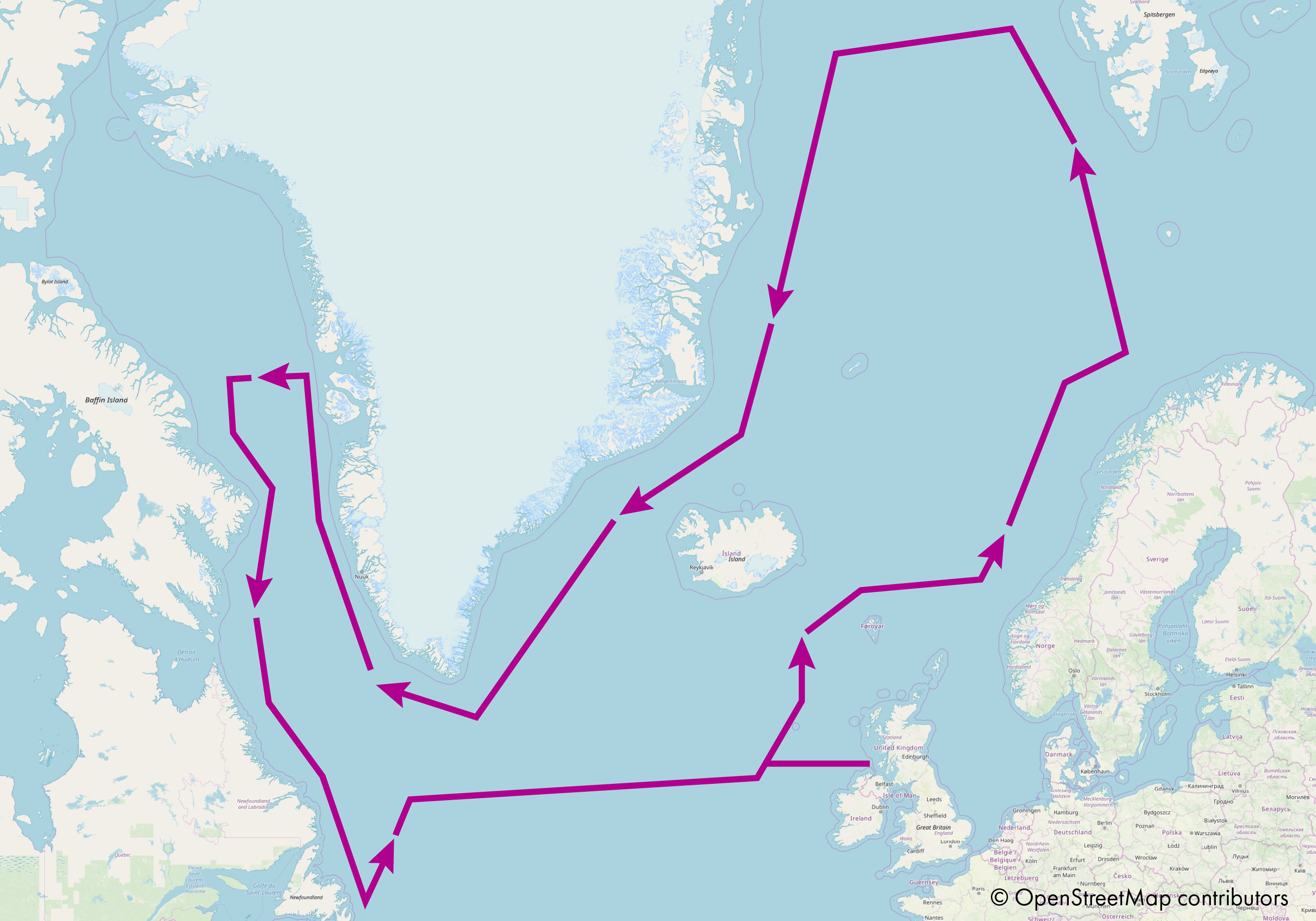
Salmon may remain in the sea for just over one year (known as 'one-sea-winter salmon' or 'grilse') or for up to 4 years (known as 'multi-sea-winter salmon')6. Their exact migration pathways in the ocean are not fully known, but evidence suggests this can be thousands of miles. A review of decades of data collection suggests that many Atlantic Salmon from southern Europe (including Scotland) follow major ocean currents, migrating north along the Norwegian coast, before turning west and following the east Greenland coastline south. They may overwinter in the Norwegian Sea, but some may continue south, reaching the southern tip of Greenland and then even follow the West Greenland coastline north. Tagged salmon from southern Europe have been recaptured off south and north Newfoundland in June, suggesting that some continue their migration south east from West Greenland, through the Labrador Sea, before finally traversing the Atlantic to complete their loop back towards the British Isles5.
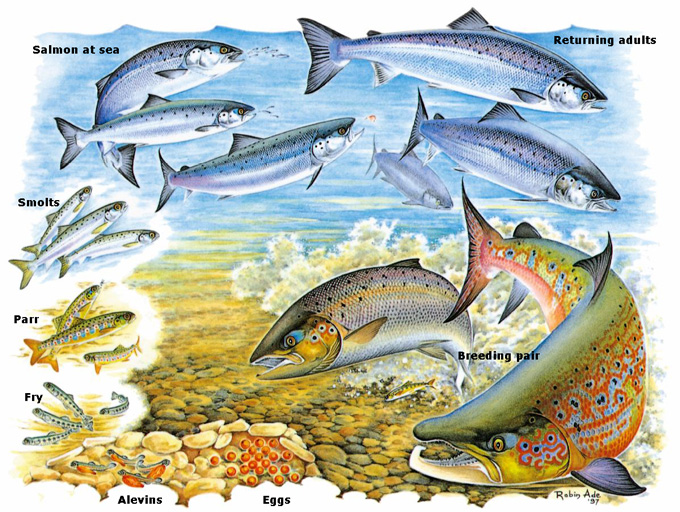
After 1 - 4 years at sea, salmon will return to their native rivers to spawn. They do this with remarkable accuracy, even ending up in the same stretch they were born6. To do this the salmon must migrate upstream, going against the current and even propelling themselves out of water to overcome obstacles such as waterfalls and rapids up to 3m high9. After spawning, salmon (now known as 'kelts') are weak from reproducing, making them vulnerable to disease and predators3. Ninety to ninety-five percent will die, but a few will repeat the process and may spawn again6.
Types of salmon fishing in Scotland
Salmon fishing in Scotland falls into three main categories:
Rod and line fishing: this takes place within rivers by recreational anglers1. It is illegal to sell a rod caught salmon according to The Conservation of Salmon (Prohibition of Sale) (Scotland) Regulations 20022. The killing of salmon in rivers is only permitted where stocks are above a defined conservation limit according to The Conservation of Salmon (Scotland) Regulations 20163.
Net and coble: this generally takes place within estuaries and the lower reaches of rivers. It involves use of a sweep net by which salmon are surrounded by the net and drawn to the bank or shore1. Netting has declined in recent years as the Conservation of Salmon (Scotland) Regulations 2016 only permit the killing of salmon in rivers where salmon numbers are above a defined conservation limit5. The largest commercial operation in recent years was on the North Esk, until being bought out by the Esk District Salmon Fishery Board for conservation reasons after the 2018 season6.
Fixed engine: these fisheries are generally restricted to the coast, outside of estuary limits1. This is with the exception of certified fixed engines within the Solway Firth, mostly in the form of 'haaf netting' involving a rectangular frame held in the current by a fisherman until a salmon enters it8. However, the Conservation of Salmon (Scotland) Regulations 2016 prohibit the retention of salmon caught in coastal waters5, meaning the only fixed engine fishing which remains is in the Solway8.
It should be noted that these methods also apply to sea trout, as salmon and sea trout are defined together in Scottish legislation2.
Importance of wild salmon to Scotland
Wild Salmon is of value to Scotland for many reasons. Not only do wild salmon fisheries have a huge economic value, salmon in Scottish rivers are also valued from a cultural, social and ecological point of view.
Ecological value of wild salmon
Wild salmon play an important role in the ecosystem, supporting a whole range of other species, whilst also acting as a 'water quality indicator' for rivers.
Fossils of fish from the salmonid family (to which Atlantic salmon belong), are first recorded ~40 million years ago. Although salmon have a poor fossil record, it is likely that Atlantic salmon have been a part of the natural environment for several million years1. As a result, salmon play a key role in the ecosystem. Due to their migratory nature - spending the majority of their adult life in the oceans before migrating upstream to spawn - salmon are an important means of delivering nutrients derived from the marine environment into freshwater ecosystems. This may be through excretion, spawning and carcass deposition2 as well as through predation by other species3. The increase in marine nutrients from spawning can lead to improved nutrient supply for species throughout the food chain, including algae, invertebrates and young salmon2, while salmon themselves are prey for a range of fish, mammal and bird species3.
In rivers, young fish are a food source for brown trout and other fish, as well as otters, cormorants, goosanders and red-breasted mergansers and herons6, while returning adults are prey for otters7. In the sea, salmon can be prey for various fish including cod, skate and Greenland sharks8 as well as marine mammals such as dolphins and grey and harbour seals9. As well as this, a freshwater pearl mussel (Margaritifera margaritifera), which is a UK Biodiversity Action Plan priority species10, has been found to have a symbiotic relationship with the Atlantic salmon of mutual benefit to the two species. Mussel larvae develop within the gills of salmon, while adult mussels improve water quality by filtering water, providing optimal reproductive conditions for the salmon11.
Atlantic salmon have strong requirements for good river water quality, in terms of oxygen levels, pH, suspended solids and chemical abundance. This, along with along with suitable access to habitat, determines their distribution across the UK, in which they are widespread in Scotland, Northern Ireland and Wales but limited in most of England7. As a result, the abundance or decline of salmon in a particular river can seen as an indicator of water quality. In the 19th to early 20th century, salmon in many central Scotland rivers were observed to be in decline, and in some places, lost entirely. This was found to be a result of domestic and industrial pollution and barriers to fish migration, and helped lead to action and subsequent improvement of water quality which allowed salmon to return13.
Economic value of wild salmon
An analysis by Public and Corporate Economic Consultants (PACEC), on behalf of Marine Scotland, assessed the economic value of wild fisheries, including both the angling and netting sectors, based on 2014 data collected through surveys and interviews with key stakeholders1. The analysis includes salmon, sea and brown trout, grayling and coarse fishing. Since many fisheries involved in the study provided fishing opportunities for multiple species, it is difficult to separate the value of individual species. However, fishing opportunities for salmon was the most common option provided by fisheries (98%) compared to other species, and salmon was also targeted by the greatest proportion of anglers (76%). Netting activities were also predominantly focused on salmon. It is likely then that salmon accounts for a large proportion of the overall economic value of wild fisheries.
The Gross Value Added (i.e. the monetary value of business and household income) of wild fisheries in Scotland was calculated as £79.9 million in 2014.
This value includes activities in different sectors, including: direct on-site activities, the supply chain to these activities, off-site impacts and the supply chain to these external sites. A large proportion of this comes through tourism, with an estimated 62% of angler expenditure accounted for by tourists.
These different sectors associated with wild fisheries were also found to have supported around 4,300 full-time equivalent jobs.
Of this value, the majority comes from angling which also supports the largest number of jobs. The analysis estimated about 65 - 80 full-time equivalent jobs to be related to the netting sector, down from 400+ in the 1990s. Most netting operators were found to be individuals, with a large number of rights being sold in the preceding years and netting ceasing to continue1. Netting has continued to decline since 20143.
The Net Economic Value (i.e. the value in monetary terms to participants and society over and above the value of the resources used) was calculated to be around £28 million per year.
The £28 million figure comprises about £17 million of value for anglers and about £11 million for the holders of fishing rights. This includes the 'existence' and 'bequest' values of wild salmon, based on the amount that people would be willing to pay in order to maintain and protect salmon stocks (existence value) and protect angling for future generations (bequest value). These results suggest that, as of 2014, anglers would be willing to pay on average 14% over and above existing costs for these purposes.
Fisheries also provide a financial asset to the owners of beats and fisheries, which may be worth several hundred million pounds where active.
Public sector support also benefit the sector, with a value of ~2.7 million/year from conservation grants; support for apprenticeships and training; and promotion to tourists1.
Social and cultural value of wild salmon
The PACEC report mentioned in the section on economic value also considered the social and cultural benefits of wild fisheries to be significant. The main social benefit being the number of jobs provided in rural areas where other employment opportunities may be limited1. Scotland has a long salmon season, open for almost 11 months of the year2, compared to other countries like Norway where it is open only three months3. This means many jobs are full-time, rather than seasonal1.
Fisheries have also provided many opportunities for learning and education, often forming links with schools to help attract young people into the industry and educate them about fisheries and the uniqueness of salmon, as well as engaging them in outdoor recreation, forestry, habitat management, ecology and conservation. Employment of young people, such as through apprenticeships, provides training opportunities and development of skills. Long-standing relationships and the organisation of activities between fisheries and other local organisations, such as environmental management groups, can help develop a sense of community within the local area1.
Wild salmon also hold a long-standing cultural value in Scotland and beyond, often being regarded as one of the most iconic species in Scotland, associated with beautiful rivers and the countryside6. Salmon are part of ancient Scottish mythology, featured in a story involving 6th century priest, St Mungo7, which led to the incorporation of salmon into the coat of arms of the City of Glasgow8. Worldwide, salmon are commonly referred to as 'King of Fish' due to their beauty9 and remarkable migrations10, and have been associated with wisdom and knowledge by the Celts7. They have played a part in human history for several millennia, with a life-size carving of a salmon found in a cave beside a river in the Dordogne region of France, dated to 25,000 years ago12.
The natural phenomenon of migrating and, in particular, leaping salmon in Scotland's rivers also provides a value to tourism as well as local people, as some people may travel to see this spectacle of nature, particularly during the autumn13.
Current status of wild salmon in Scotland
Wild salmon numbers are in decline across Scotland, with rod catch of salmon in rivers reaching the lowest numbers on record in 20181. As a result, many Scottish rivers have been recognised as having a poor conservation status2.
Salmon fishery statistics 2018
The salmon fishery statistics published by the Scottish Government include data on rod and net catch of salmon since 1952, as well as data on how much effort went in to net fishing1. These data should be viewed together, since changes in net catch at the coast, for example, will affect the number of fish caught in rivers. The amount of net fishing effort will also largely control the net catch, rather than reflecting salmon abundances directly.
For the 2018 season, total rod catch numbers (retained plus released salmon) were the lowest since records began. Salmon catches can be split into spring salmon (multi sea-winter salmon caught before 1st May), summer salmon (caught after 1st May) and grilse (one sea-winter salmon). Summer salmon catches show large year-to-year fluctuations with no clear long-term trend, in contrast to spring salmon which have been in continued decline since the 1950s, and dropped sharply in the early 1980s2.
The long-term trend in total rod caught salmon indicates an overall increasing trend from 1952 to 2010, followed by a sharp decline towards the lowest numbers in 2018.
This trend in total rod caught salmon is mostly driven by reported grilse numbers, which largely increased from the 1950s up until 2010, before rapidly declining2. It should be noted that total catch numbers since 1992 are numbers of salmon retained plus those released. Prior to this, only salmon retained are recorded2.
However, these data are raw catch numbers and do not take into account the fishing effort (i.e. the amount of fishing) or the conditions experienced (e.g. flow rate) that may affect the numbers of fish caught. As such, they do not directly equate to salmon numbers, but they do indicate an overall trend towards declining salmon in recent years. Data on angling effort for rod and line fisheries is not currently available, so it is not clear how changes in the number of anglers or length of time spent fishing may affect these statistics.
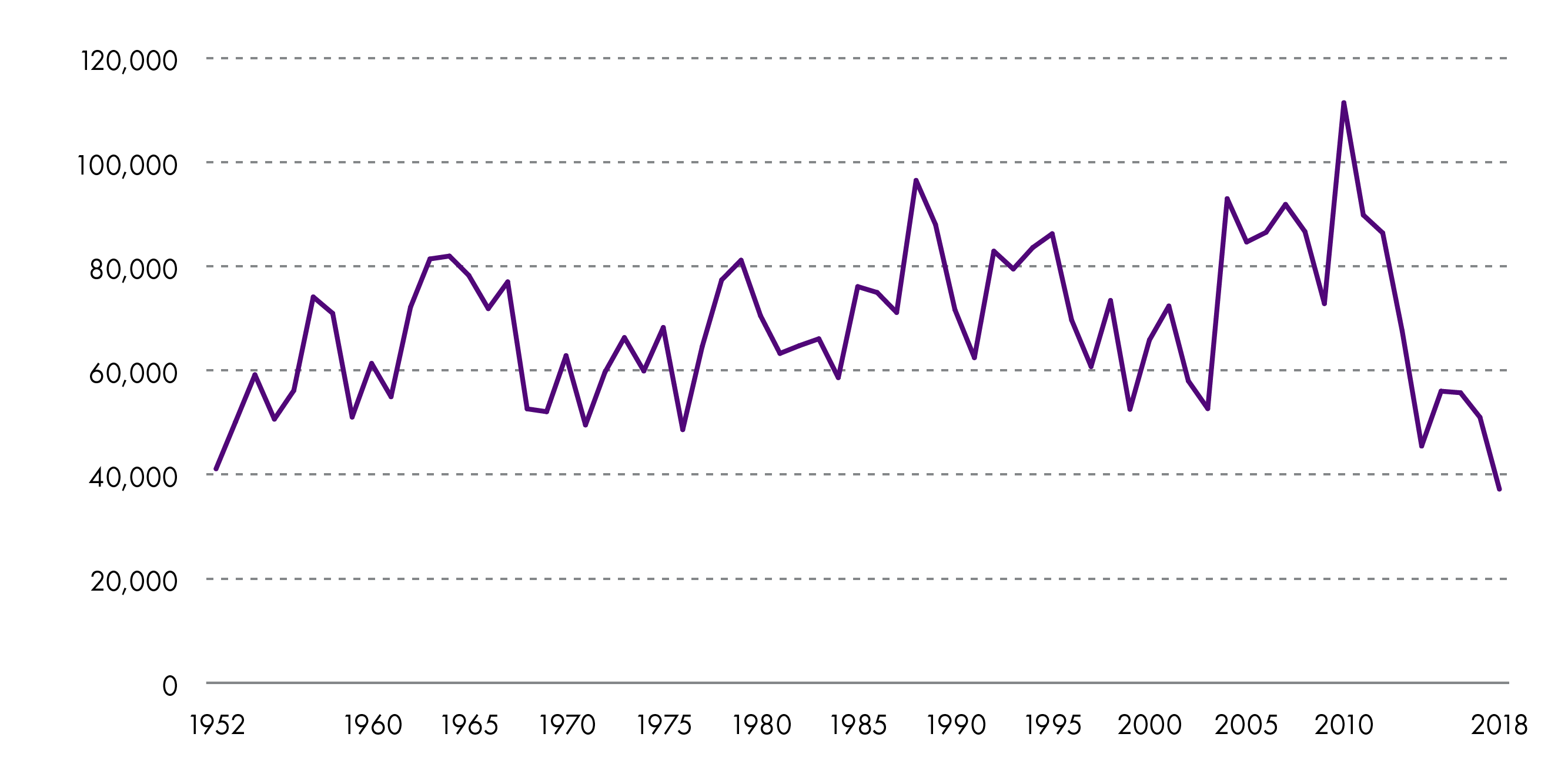
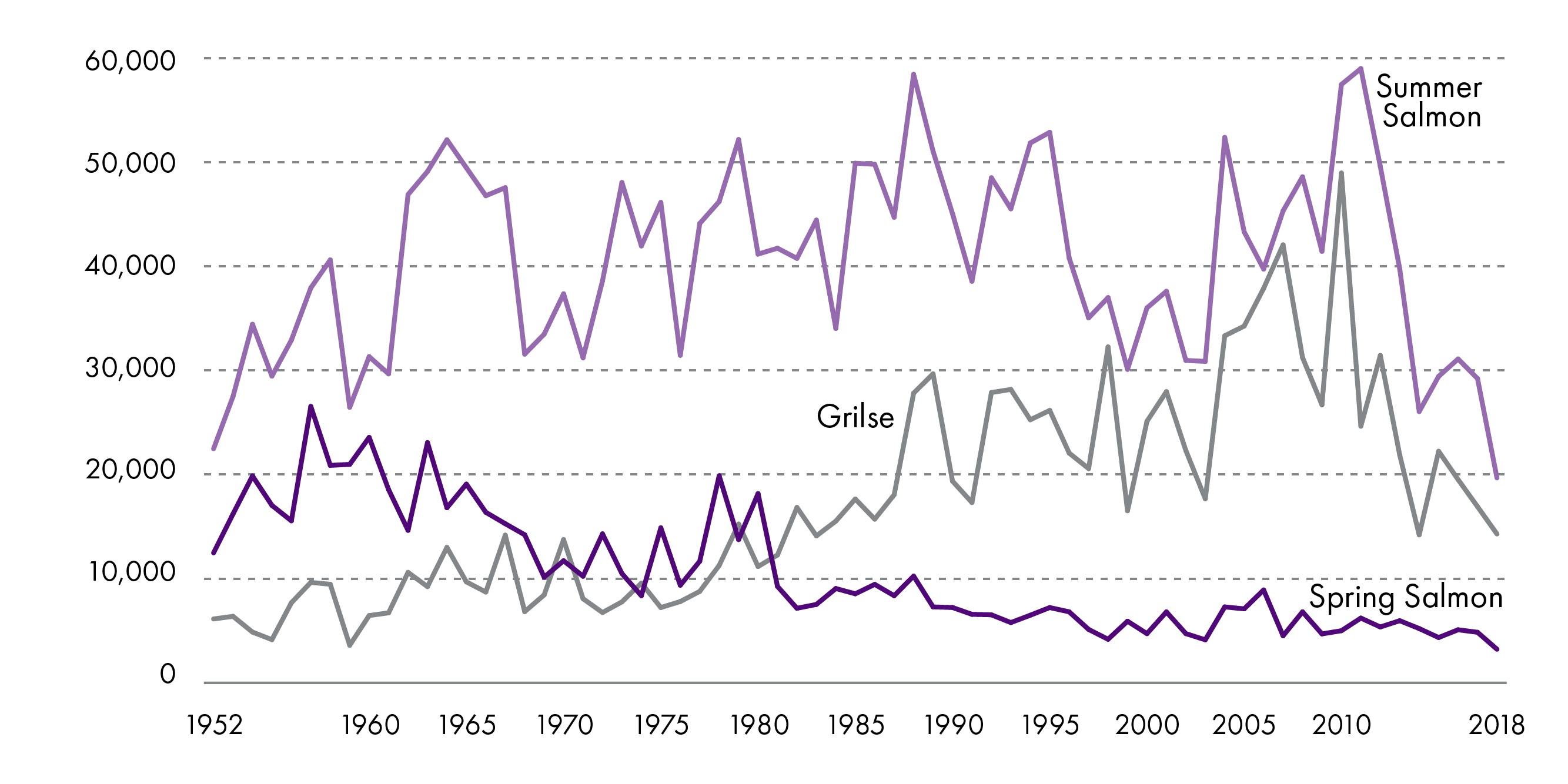
Catch numbers for net fisheries in 2018 are also one of the lowest on record, having been in sharp decline since the 1960s. However, these catches should be viewed alongside net fishing effort (below) as the amount of fishing will be largely driven by the amount of fishing which takes place.
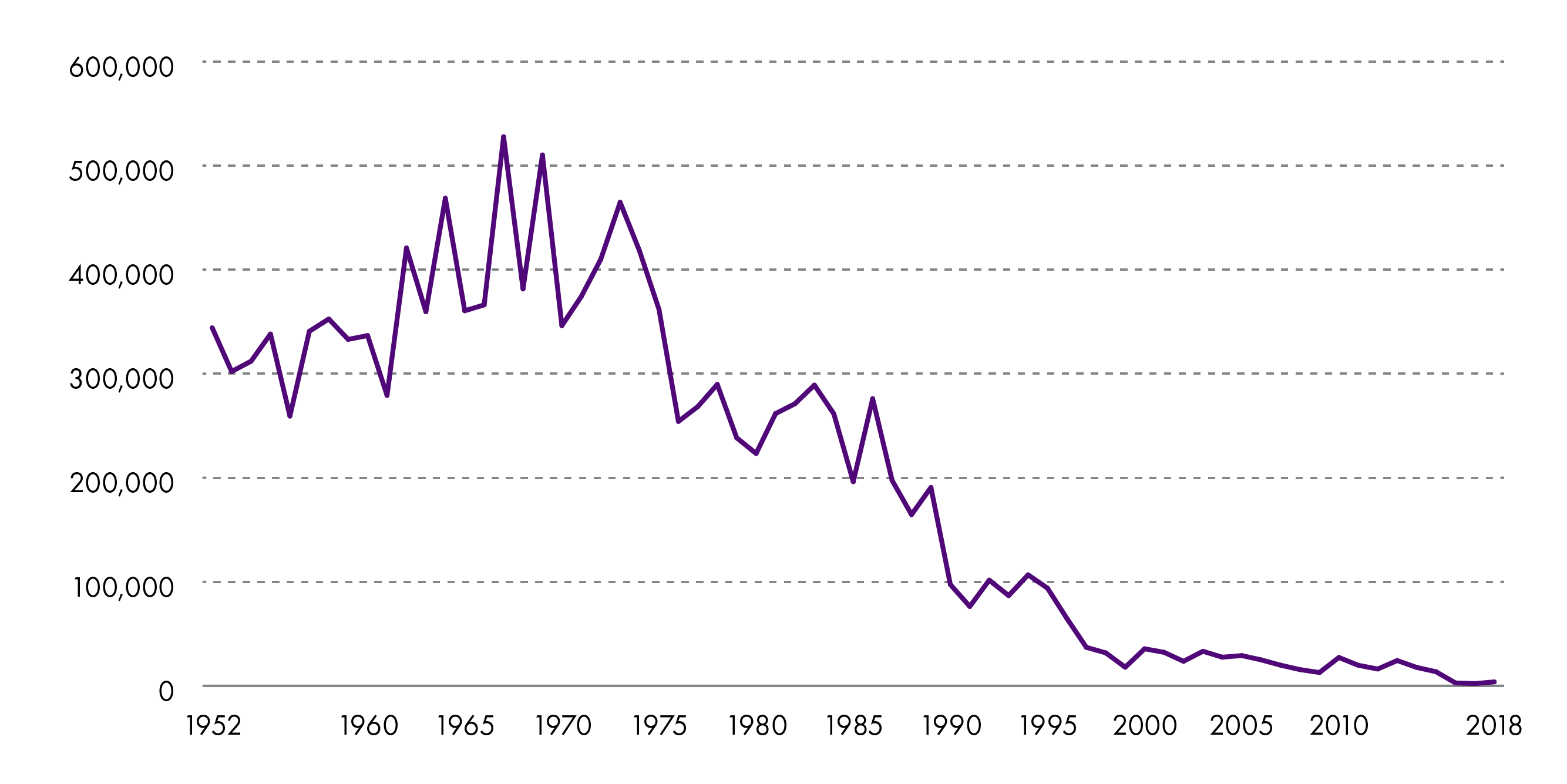
For the netting industry, netting effort (based on the number of fishing crews each month for 'net and coble' and the number of traps used per month for 'fixed engine' methods) has declined continually since the 1950s, as seen in the figures below1. This is a result of many net fisheries being bought out by district salmon fishery boards for conservation reasons9.
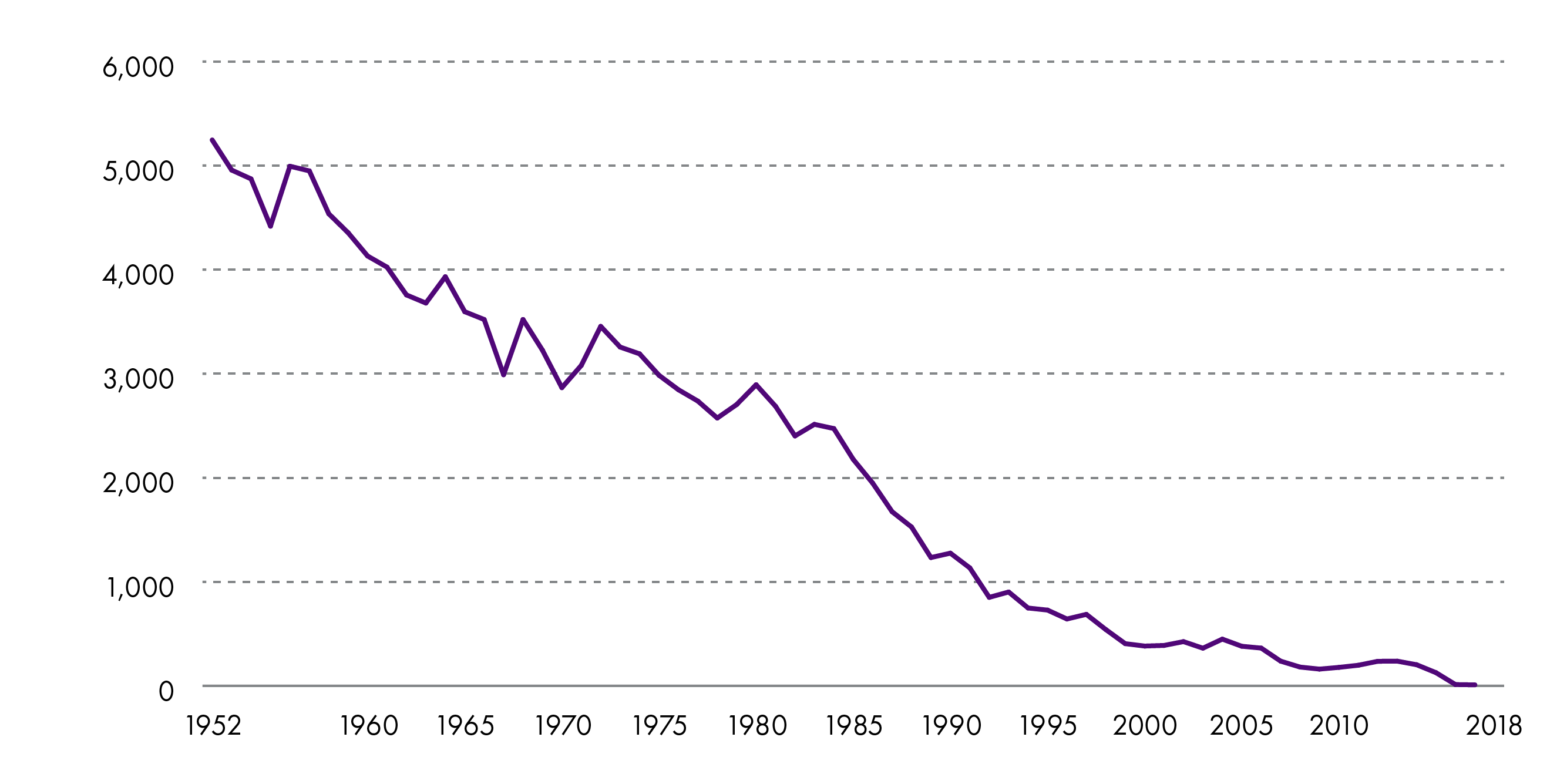
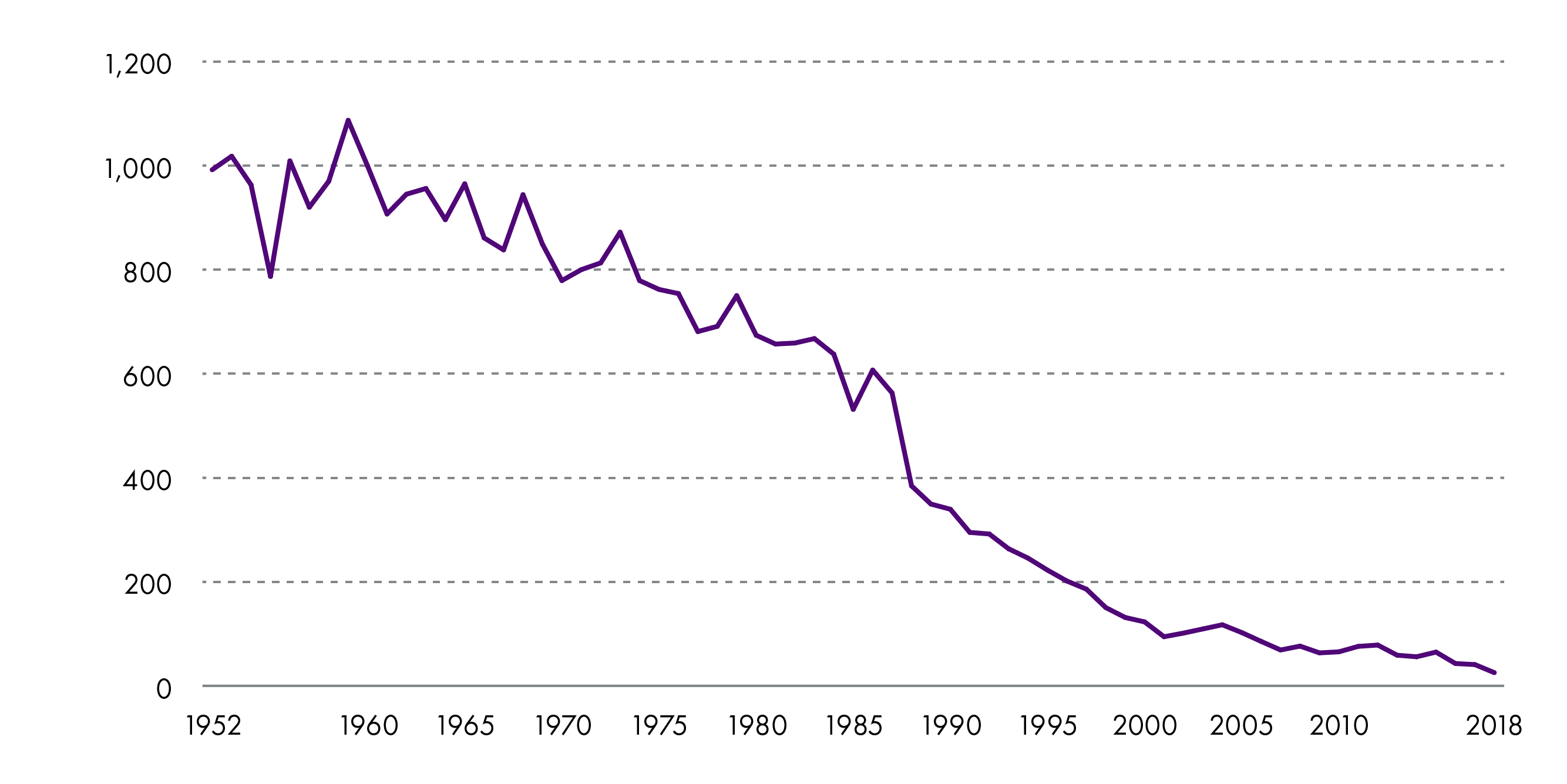
Estimated numbers of salmon returning to the Scottish coast have been calculated by the International Council for the Exploration of the Sea (ICES) Working Group on North Atlantic Salmon, based on both rod and net catch. Despite rod catch data suggesting an increase in numbers until 2010, these estimates show a clear decline in salmon returning to the coast since the 1970s12. This discrepancy is due to the reduced exploitation at the coast (as indicated by declining net catch and effort) allowing salmon rod catch to increase (at least until 2010), despite overall numbers declining13.
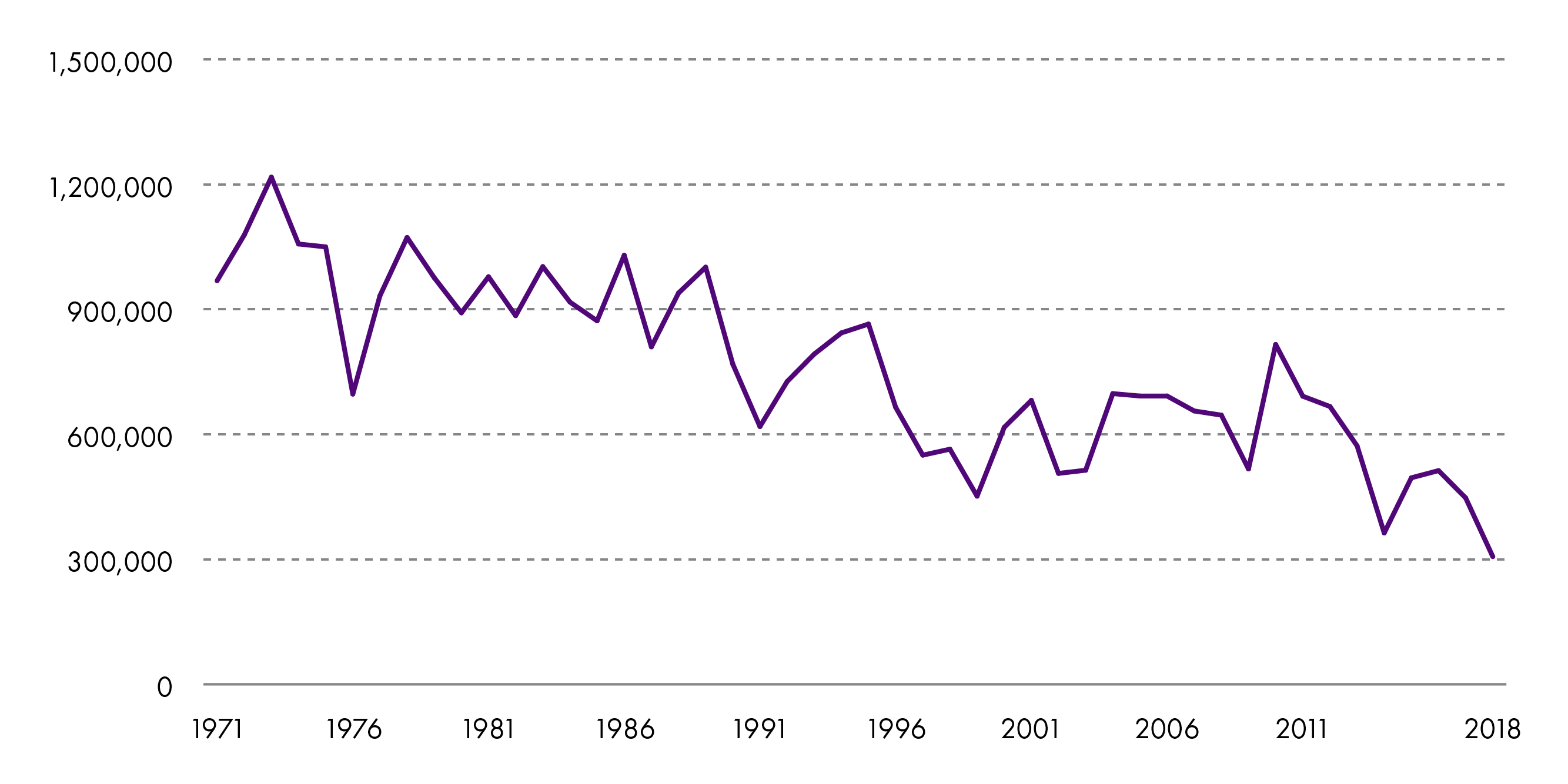
Assessing the conservation status of wild salmon
The Conservation of Salmon (Scotland) Regulations 2016 states that an assessment of the conservation status of salmon must be carried out for all inland waters, based on both the stock level and condition of salmon1. Marine Scotland assess the conservation status of all Scottish rivers each year. This is based on the probability that a population of salmon will meet its conservation target over a five-year period. As such, each river is assigned a grade (category 1 to 3) which determines the recommended management actions2. For rivers assigned as grade 3 it is illegal to retain salmon. This means that any salmon caught must be released back into the water (known as 'catch and release')3.
Conservation assessment methods
To determine the conservation status of each river, Marine Scotland use data from scientists and anglers to estimate:
how many salmon eggs will be deposited in each river
the likelihood of the number of eggs reaching a level which will maintain stocks at sustainable levels.
These methods involve a number of different steps1.
Step 1: Converting rod catch to numbers of returning adult salmon
A basic model is created to calculate what percentage of salmon which are caught by anglers. On rivers which have fish counters (automatic devices measuring the number of fish passing along a river), the number of fish counted can be compared to the number of fish caught by anglers further upstream. This is then used to produce a model which can estimate salmon abundance for rivers which do not have fish counters.
Step 2: Estimate the number of salmon in each river
The model also accounts for variation in the relationship between fish counters and rod catch due to the month of the year and flow rate.
For a given count, catches tend to be:
lower during the summer than the spring or autumn
lower in low flow conditions where salmon appear to be harder to catch compared to high flow conditions.
Data on the return profile of rivers (i.e. the seasonal variation of salmon counts) and flow rate allows estimates of the numbers of salmon returning outside the fishing season.
Step 3: Calculate the number of eggs which will be deposited
The estimate of adult salmon abundance is used to work out how many eggs will be deposited. This requires knowing how many fish will be female and their size
The percentage of female salmon is calculated using historical data about how the percentage of female fish in each age class (i.e. one or multi-sea-winter fish) differs with month, year and location. The number of eggs produced by each female is related to its age and size and is also estimated using historical data on the egg content of salmon in relation to month, year and location.
Step 4: Compare the number of eggs to the egg targets
Each river has an egg target – the number of eggs required to maintain salmon stocks at sustainable levels. This is estimated from rivers where information is available on the relationship between the number of eggs deposited and the number of adults those eggs will produce. Uncertainties involved in estimating egg numbers and requirements are combined to calculate the percentage chance that an egg requirement has been reached for the previous five years.
Step 5: Assign each river a conservation status grade
The grade of the river is determined by the percentage chance that an egg requirement has been reached for the previous five years. These are defined as:
Grade 1: >80% chance the egg requirement has been met over the past 5 years.
Grade 2: 60-80% chance the egg requirement has been met over the past 5 years.
Grade 3: <60% chance the egg requirement has been met over the past 5 years1.
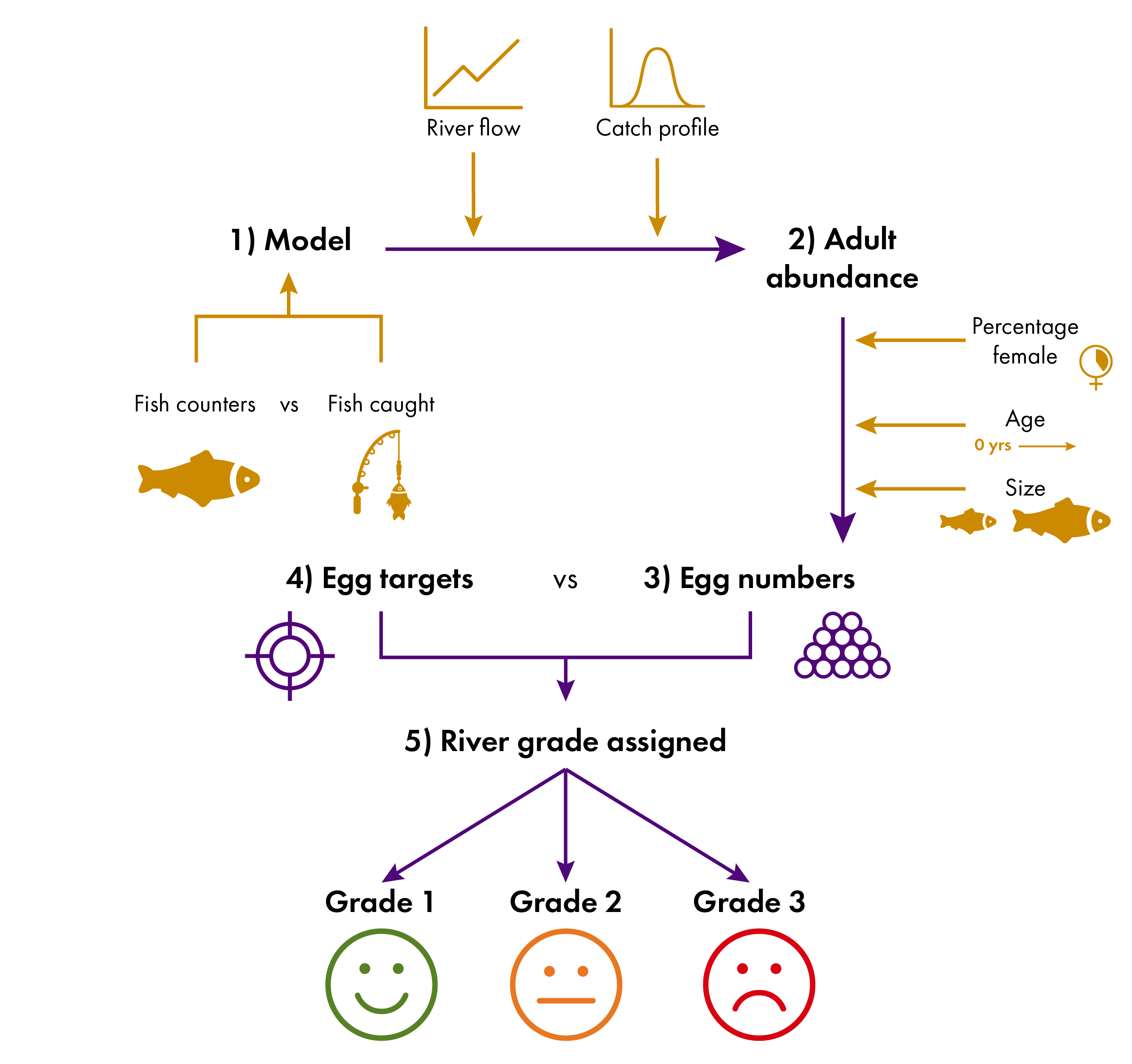
The river grade determines the management which is required, as set out by Marine Scotland. This advice is as follows:
Grade 1: Exploitation is sustainable. No additional management action is currently required.
Grade 2: Catch and release should be promoted strongly to reduce exploitation.
Grade 3: Catch and release is mandatory as exploitation is unsustainable.
Conservation assessment for the 2019 season
The assessment for the 2019 fishing season, based on data from the 2013 - 2017 period, categorized Scotland's rivers as follows:
49 rivers as grade 1
30 rivers as grade 2
94 rivers as grade 3.
Grade 3 rivers appear to be slightly more prevalent along the west coast of Scotland, whereas grade 1 is more common in central Scotland and the east coast1.
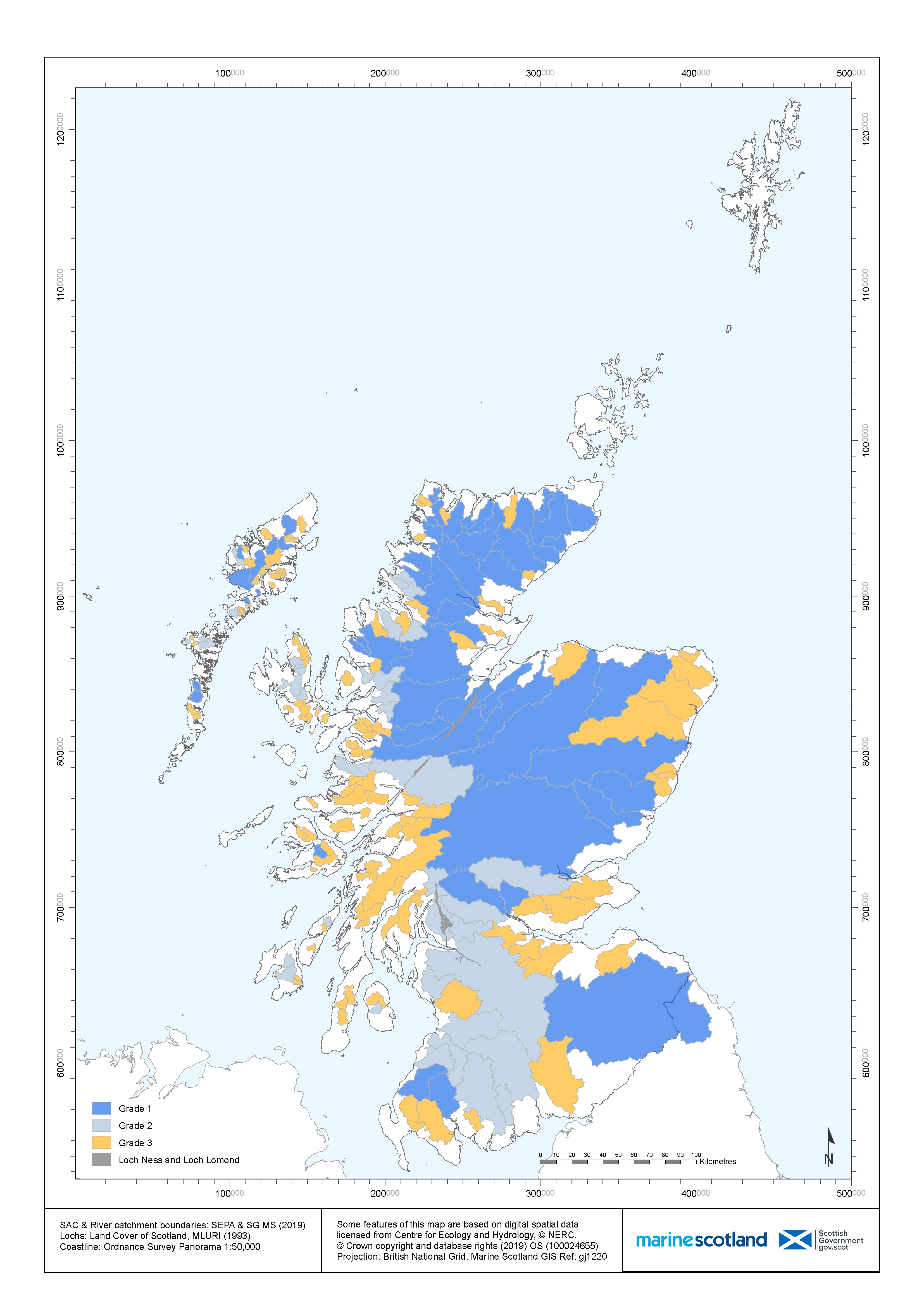
These gradings differ significantly from previous years, notably the number of grade 3 rivers being reduced from 122 (2018) to 94 (2019). However, it must be noted that this is due to a change in the assessment methods used, and not an improvement in river conditions. When these new methods are applied to previous years (2011 - 2015 and 2012 - 2016), there is a progressive increase in the number of grade 3 rivers, which is in line with the decline in reported catch numbers3.
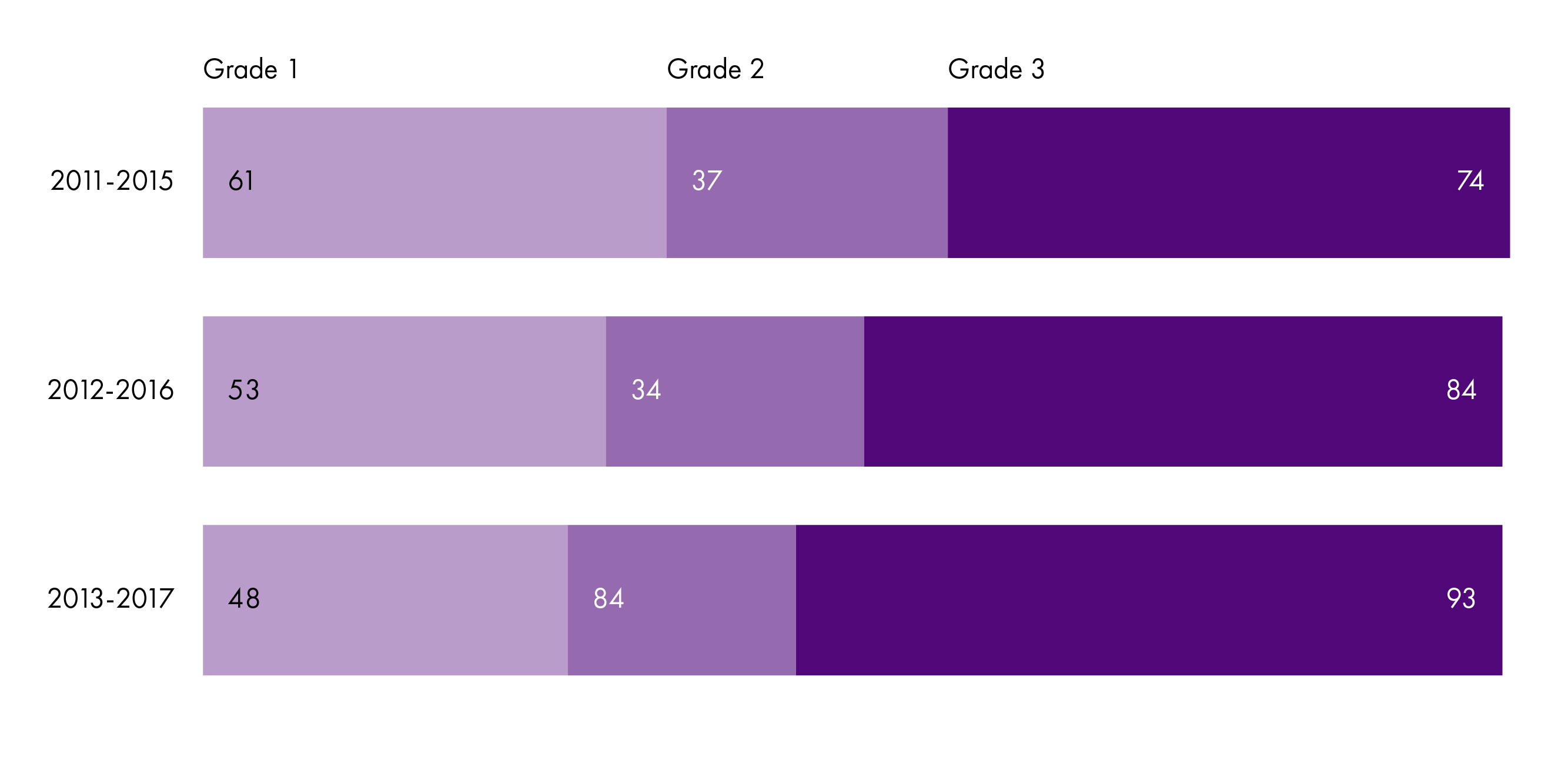
New egg requirements, or targets, are used in these updated methods which are based specifically on data from Scottish rivers, compared to more general data previously used. The main difference is that fewer eggs are required for maintaining stocks at a sustainable level. This explains why the new assessments categorize fewer rivers as grade 3. The updated methods also remove a geographic component in the assessment of adult salmon abundance5.
Status of other wild fishes in Scotland
As well as wild salmon, various other fish species in Scotland are also in decline, including sea trout, eels and Arctic charr.
Sea trout catch data is available between 1952 and 20181. Combined rod and net catch of sea trout in 2018 was the lowest on record. Net catch follows a very similar trend to that of salmon, reaching a peak in catch numbers in 1967 followed by a continued decline. This is mirrored by a decline in netting effort, as is the case for salmon. Rod catch also shows an overall decline for most of the record after peaking in 1966. This is in contrast to salmon which instead increases until 2010, declining thereafter.
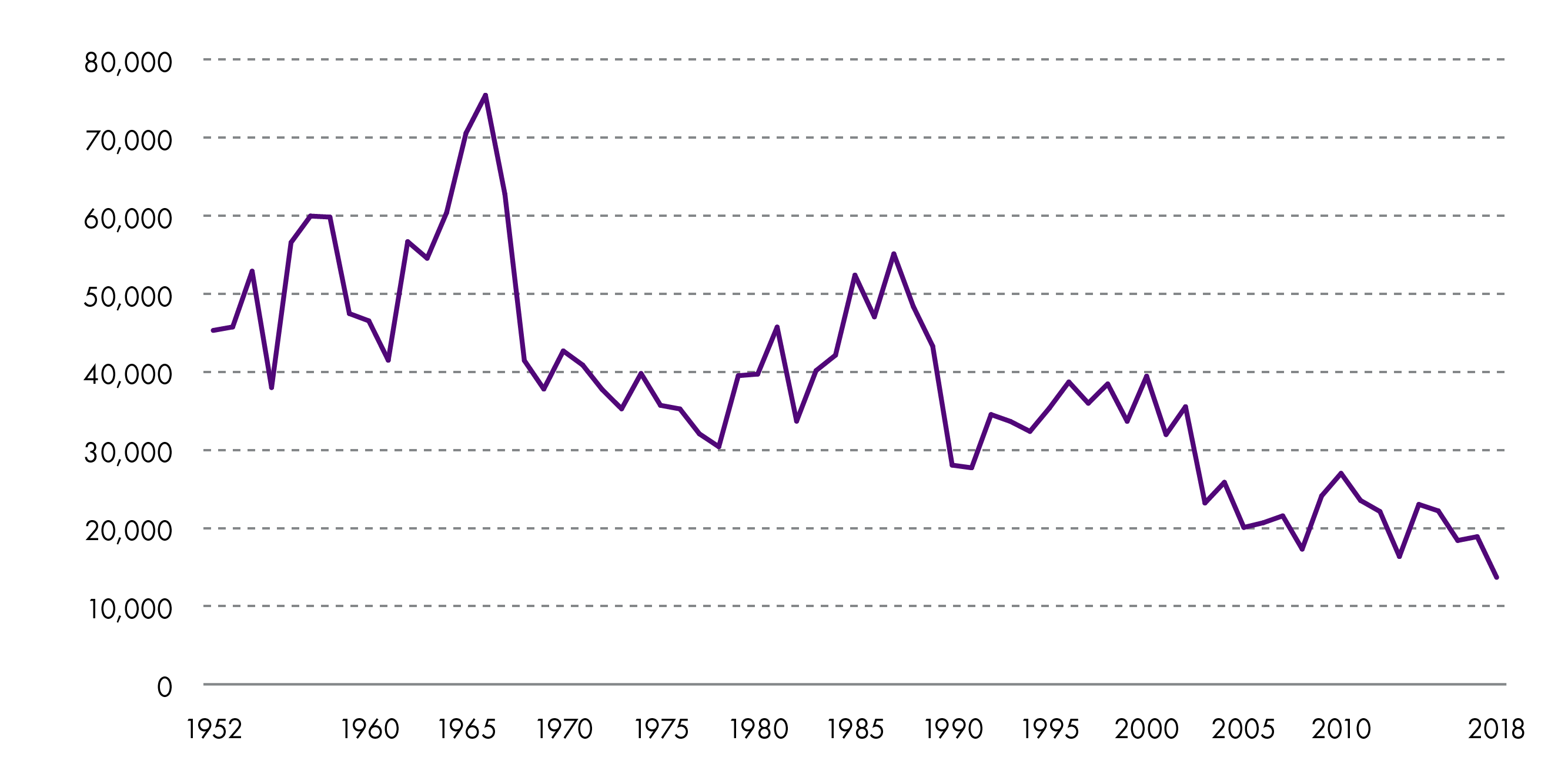
Sea trout have a superficially similar life history to salmon. Spawning takes place in freshwater, and where there is access to the sea, some trout will migrate to feed in the marine realm3 after 1 - 4 years feeding and growing in rivers. However, in contrast to salmon, sea trout will stay mostly in coastal waters where they will sometimes remain for only a few weeks or months. Although there is a degree of overlap in spawning and nursery habitats of salmon and sea trout, sea trout also spawn in smaller coastal streams and the tributaries of large rivers compared to salmon4.
In contrast to salmon, eels live in rivers for most of their lives, but breed in the sea. They may remain in freshwater for up to 30 years (males), or 50 years (females), before migrating to their spawning grounds in the Sargasso Sea in the mid-Atlantic. The number of juvenile eels arriving in Europe from the Atlantic has declined since 1980 and is now thought to be just 5% the average level of the 1970s. As a result many eel fisheries, including in Scotland, closed5 Fishing for eels is now illegal without a license under the Freshwater Fish Conservation (Prohibition on Fishing for Eels) (Scotland) Regulations 20086.
Arctic charr are another salmonid species found in Scotland, which similarly spawning during the autumn but generally on loch shores as opposed to streams7. One study compared abundances of Arctic charr in five lochs in Scotland between summer 2003-05 and 2007-08. Arctic charr declined significantly between the two periods in four out of five lochs, with only the most northerly site (in the Shetland Islands) increasing. Arctic charr at six other sites in the UK, also analysed in the study, also declined since 1990, leading the authors to suggest that climate change is a significant factor behind their decline8.
Global status of wild Atlantic salmon
Catches of wild Atlantic salmon are found to be declining all across the North Atlantic. The International Council for the Exploration of the Seas (ICES) Working Group on North Atlantic Salmon has compiled data on the nominal (declared) catch of salmon since 1960 for four North Atlantic regions (northern Europe, southern Europe, North America and Greenland & Faroes). In all regions, salmon catch numbers follow a remarkably similar pattern, peaking in the early 1970s followed by a gradual decline until the mid 1980s and a more rapid decline until the mid 1990s. Similar year to year fluctuations in salmon catch occur in all regions, with notable short-term declines in salmon catches recorded in all areas in 1978 and 19841.
For 2018, the total nominal catch for all regions was estimated at 1090 tonnes, 283 tonnes below the mean for the previous ten years1. Salmon catches reflect a combination of different things including:
salmon abundance
changes in fishery types
the impact of management measures3.
This means that practises such as catch and release are not included in these nominal catch numbers, and so the decline in catch may partially reflect adoption of this practise, in addition to changes in exploitation rates1. The use of catch and release may particularly affect catch numbers in Southern Europe (which includes the UK, Ireland, France and Spain) where Scotland had the highest percentage of catch and release (93%) in angling fisheries of any country part of the North Atlantic Salmon Conservation Organisation (NASCO)1.
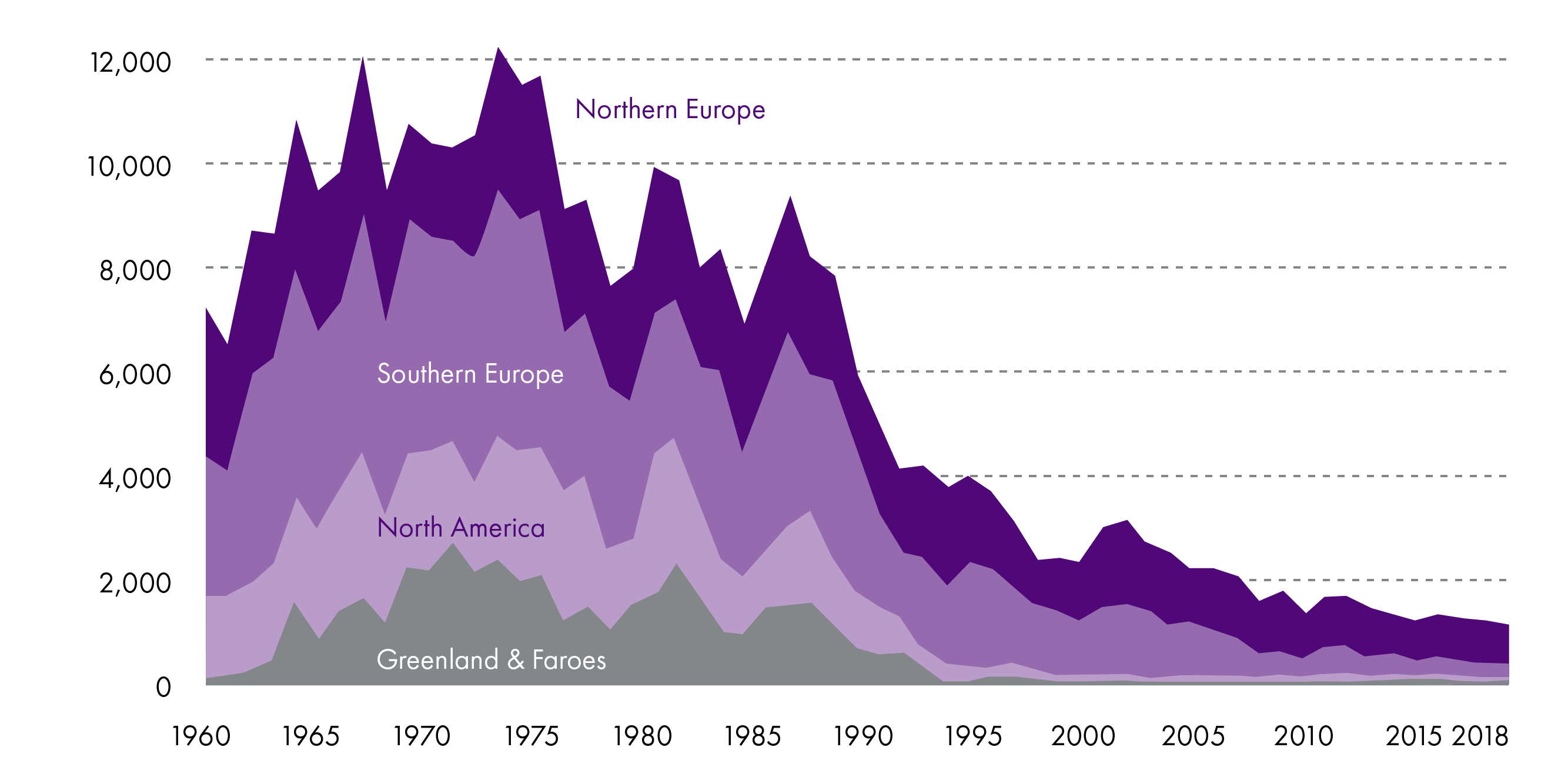
A life cycle model has been developed to estimate the abundance of post-smolts at sea before any reaching any fisheries, from North America and southern Europe from 1971 to 2014. The model showed a continued decline in the marine survival of salmon over this time, along with an increase in the number of fish returning as grilse (one-sea-winter salmon) 1. This increase in grilse is seen in the Scottish salmon catch figures8.
Potential drivers of Scottish wild salmon decline
Due to the migratory nature of Atlantic salmon, covering thousands of kilometres throughout Scotland's rivers and within the North Atlantic ocean, there are a huge number of different pressures which affect salmon survival and reproductive success. These factors can broadly be split between the main migratory zones:
rivers
estuaries and the coast
the open ocean.
In each of these areas there will be different factors affecting wild salmon, although there will also be some overlap.
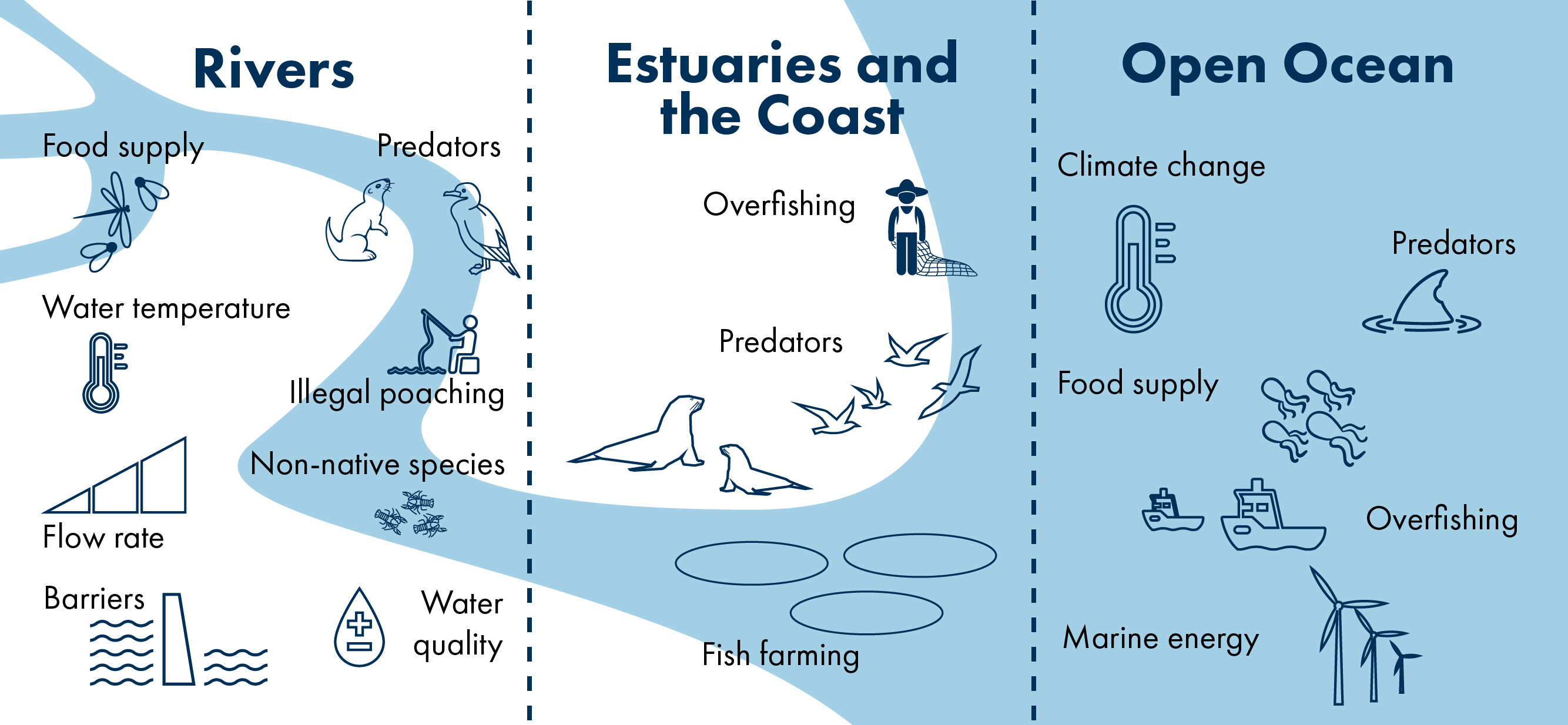
Pressures on salmon in rivers
Salmon spawning primarily takes place in the gravelly upstream areas of rivers and streams, where there is clean and fast-moving water. The young fish may stay for 1 - 4 years as they develop from eggs to smolts. After this time, the smolts will migrate downstream towards the sea. Returning adults will later migrate back up through rivers, going against the flow to reach their spawning grounds1.
During this time, a number of factors are likely to affect their survival including:
water temperature
water quality
predators
barriers
flow rate
food supply
illegal poaching
invasive non-native species.
Research has shown that survival of salmon in their juvenile stages is density-dependant. This means that, above a certain level, a greater population density, can lead to a greater loss-rate, since high densities can lead to competition and lack of food, and increased vulnerability to predators. This means that the number of eggs deposited is not directly proportional to the number of adults which return. This is in contrast to survival of adults in the ocean where - assuming a constant mortality rate at sea - the more smolts reaching the sea, the more adults returning to spawn2. Furthermore, young salmon have been shown to exhibit 'compensatory growth' following periods of sub-optimal conditions which may reduce their growth. This means they grow more rapidly to compensate for the loss of growth during poor conditions3. Because of this, it should be noted that negative effects on young fish in their nursery habitats, either through mortality or reduced growth, may not always have a direct effect on future adult populations.
Water temperature
River water temperature plays an important role in the growth and survival of Atlantic salmon. Specific optimum temperatures and lethal limits differ for each life stage. Water temperature in turn is determined by a number of different factors.
Effect of water temperature on salmon
River water temperature can affect salmon in a number of ways, varying depending on the life stage:
Eggs are the most vulnerable to changing temperatures. The upper lethal limit is 16°C, however, the optimum for egg hatching is 4-7°C. Winter temperatures exceeding this range have been observed in some UK rivers1.
Higher temperatures resulting in a shorter incubation time for eggs2.
Incubation temperature affects embryo condition including muscle fibres and weight at hatching - the latter being lower at high temperatures2.
Newly hatched fish experience 'thermal stress' at 23 - 24°C.
Older juveniles, including smolts, experience thermal stress at 22- 28°C2.
Salmon growth can be enhanced at higher temperatures, meaning the age of smolting (transition to migratory stage), can be advanced at higher temperatures2.
Warm water in spring is correlated with the start of the smolt run, with waters of 10°C thought to trigger migration2.
The upper temperature limit for salmon growth is 15.9°C, but the temperature for maximum growth efficiency is ~13°C1.
Temperature also effects oxygen levels, for which salmon also have specific requirements1.
A drought in the UK in 1976 resulted in high mortality of adult salmon in the River Wye, as well as juvenile mortality in a tributary of the River Severn, due to the water reaching these temperature limits1.
Water temperature can also indirectly affect salmon through changes in food availability.
Controls on water temperature
The main factors of change which affect river temperature are:
climate change
riparian (riverside) vegetation
channel orientation
river flow rate.
Climate change projections suggest significant increases in global river temperatures before the end of the century, even under the more conservative emissions scenarios, in response to increasing air temperatures. Scottish rivers are thought to be particularly susceptible to such change, with an increase of 2°C or more predicted by 2050 for rivers in the Scottish Highlands1. An increase of 2-3°C has already been observed on the River Spey over the last century2.
The presence or absence of riparian vegetation - plants along the banks of rivers - has been shown to have a significant effect on river water temperature. This is due to vegetation providing shading from the sun, reducing river temperature in summer by 2-3°C on average3. As a result, riparian planting has been adopted in some places as a method of keeping rivers cool in summer4. The type of vegetation has also been shown to be important in determining the amount of cooling it will provide. One study in the Loch Ard Forest, Scotland, found sites with conifer plantations had mean summer stream temperatures 1°C cooler than those with open grassland, and 0.5°C cooler than semi-natural deciduous woodland. This is due to the greater level of shading provided by the dense vegetation, in contrast to open grassland sites5. However, it must be noted that native broadleaved trees are generally considered more beneficial than non-native conifers. Conifer plantations can have adverse effects on the habitat including too much shading reducing light levels in the river (with knock-on effects for food supply), acidification of rivers and out-competing other tree species3.
The orientation of river channel and river flow rate is also important in determining the effect of riparian vegetation on river temperature. Where vegetation density is less than 100% (i.e. plants do not overhang the entire stream width), its orientation in relation to the sun is very important in determining how much cooling it will provide. For example, a model simulation found that with vegetation overhanging only 30% of the stream width, in a section of the Girnock Burn, Aberdeenshire in a northwest - southeast orientation under low flow conditions at midday, may have water temperature up to 7.5°C cooler than a section in a southeast - northwest orientation7.
River flow rate is also important, as faster water has less time for heating, compared to slower water. As a result, riparian vegetation has a greater cooling affect in slow flowing reaches of rivers7.
The presence of pools within rivers can also provide a refuge for young salmon during drought periods, providing cooler temperatures in the deeper water9.
Implications for management
Planting of riparian (riverside) vegetation can reduce stream temperatures and alleviate some of the problems associated with climate change. Optimal planting would be on the south bank of east-west oriented rivers and vice versa, especially in reaches with low flows. Channel oriented north-south and vice versa would require much denser vegetation to provide full shading, so may be a lower priority for targeted riparian planting to reduce stream temperature1. Riparian vegetation could have additional benefits of increasing salmon food supply (terrestrial invertebrates)2, reducing run-off of pollutants3, as well as other ecological4 and climate5 benefits of riparian planting. However, it should be noted that too much shading could also have negative effects on salmon food supply3. Native broadleaved trees are generally preferred over non-native conifers due to potential adverse affects of conifer planting, including acidification of rivers; too much shading reducing light levels and growth of other plants; and susceptibility to wind damage7.
River restoration - the re-establishment of natural physical processes, features and habitats8 - includes restoration of pools that provide shade or deep water that limit direct heating from sunlight9. Accumulation of woody material in streams slows the water flow and creates pools and eddies providing refuges where fish can avoid direct sunlight and keep cool. Additional benefits include a greater provision of invertebrate food sources and places for fish to hide from predators8.
Water quality
Water quality is often defined in terms of its biological and chemical status. In Scotland, significant deterioration of river water quality occurred in the 19th and 20th centuries mainly through the discharge of sewage and enormous changes in agricultural and industrial practices. Significant efforts to restore Scotland's rivers did not occur until 1965 with reductions in heavy industry, new legislation and increased environmental awareness leading to improvements in river quality in recent decades. Since the early 1990s, 80-90% of Scotland's rivers have been described as unpolluted. The change in polluted status of rivers since 1992 is shown in the graph below1.
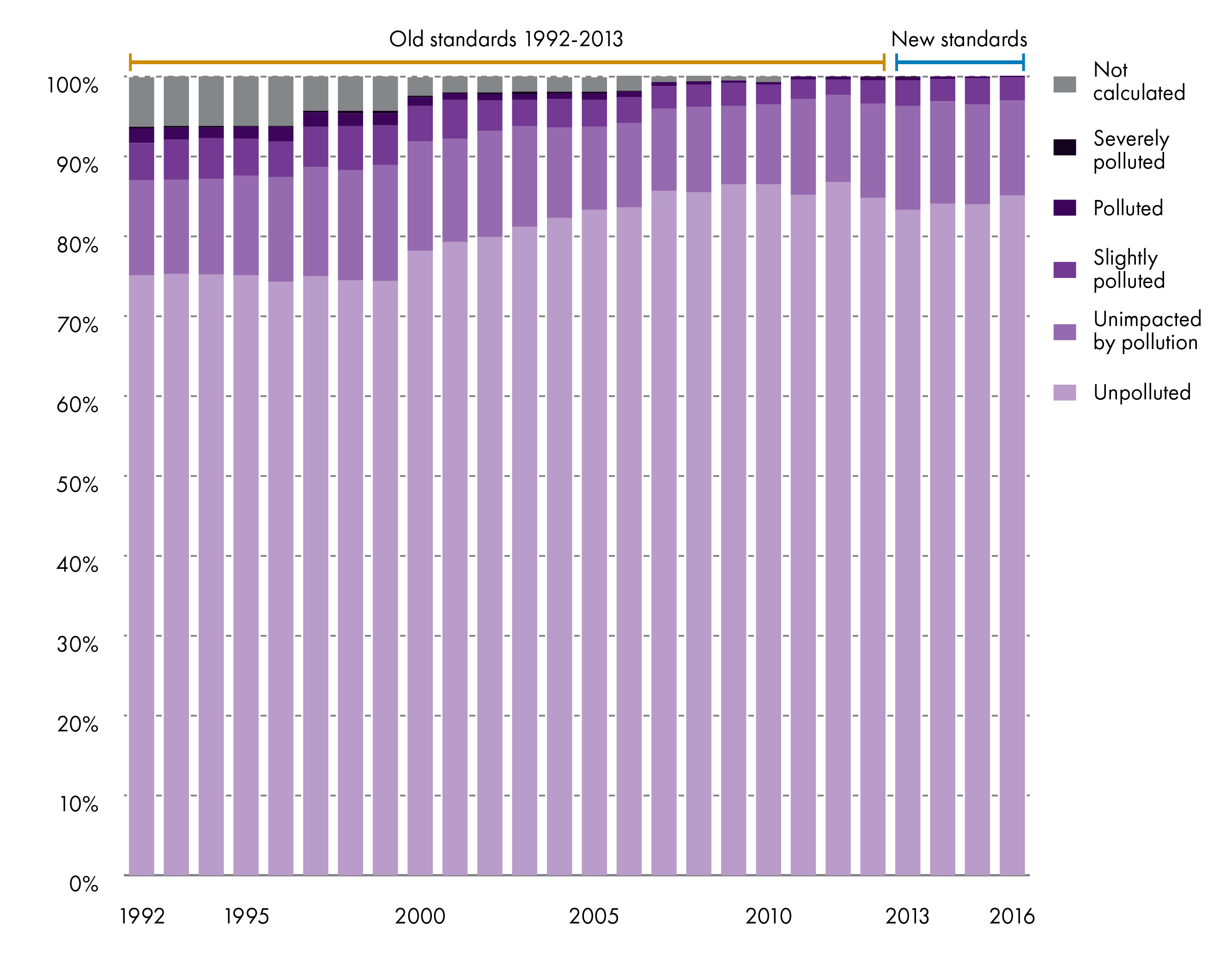
Atlantic salmon are sensitive to a range of water quality parameters, particularly in terms of:
pH
dissolved oxygen
nitrogenous compounds
pesticides
suspended solids.
It should be noted that these water quality elements are often interlinked and can work together, along with water temperature and flow rate, to cause negative consequences for salmon.
pH
Acidification of rivers - entailing a reduction in pH - can have an affect on salmon populations. In Norway, more than 50 rivers were observed to be affected by acidification in recent decades, resulting in reduced salmon numbers and, in the case of 18 rivers, extinction of salmon1.
However, pH limits for salmon depend on other other water quality parameters. For example, acidification results in an increase in aluminium (Al) concentration1 - which is naturally abundant in the Earth's crust3 - and the two act in concert. Al consumption can lead to respiratory problems and, in some cases, death. The biological response of salmon to acidification depends on both the pH and Al concentration, as well as the timing and duration of the event, the prior health and life stage of the fish, as well as other water quality elements. Research on salmon in Norway found only when water dropped below pH 4.5 in the absence of Al did pH have a direct negative effect on salmon. However, where Al concentrations were high, a pH > 5.4 could have negative consequences. It was also found that smolts are more strongly affected by acidification than younger fish, and that exposure to these conditions could result in rapid mortality or a delayed response1.
Dissolved oxygen
Dissolved oxygen in water is required in every life stage of salmon for respiration, with a higher requirement the smaller the fish1. The level of dissolved oxygen correlates with the success of developing salmon embryos. A study of salmon and trout embryo development in 4 sites in Aberdeenshire showed a strong relationship between dissolved oxygen concentrations and embryo survival. Where dissolved oxygen concentrations were below 7.6 mg/L, embryo survival was minimal. In contrast, there was almost 100% survival rate above 11.5 mg/L2.
A lack of oxygen in spawning redds can also result in reduced growth, premature hatching, reduced size at hatching and changes in the morphology of salmon3.
Nutrient pollutants
Nutrients pollutants in rivers commonly originate from run-off from rural and urban areas, particularly agricultural land1. Some of the main pollutants which affect salmon include:
ammonia
nitrite
nitrate
phosphorus
Ammonia is a toxic, nitrogen-based compound which can cause adverse health effects and mortality in salmon populations. It is thought that Atlantic salmon are one of the most vulnerable fish species to ammonia toxicity. A lab-based study on young salmon from a fish farm in Norway looked at the lethal concentrations of ammonia at different temperatures and pH levels. The study found that temperature was very important in determining salmon susceptibility to ammonia, and that toxicity decreased with increasing temperature, at least up to 17.1°C. However, other studies have suggested that toxicity may increase again above optimum temperatures. The form of ammonia present and the length of exposure are also important factors in salmon mortality, as well as the presence of salts. For the latter, high salinity conditions have been found to reduce toxicity2.
Ammonia will normally combine with oxygen to form nitrite, which is very toxic to fish3. The effects of nitrite on Atlantic salmon include:
Swelling and delayed hatching of eggs.
Delayed weight gain of young fish and developmental abnormalities due to inadequate oxygen supply4.
Nitrite passed into the bloodstream via gills can reduced oxygen supply, resulting in anaemia3.
Mortality of eggs and young fish at high enough concentrations4.
Nitrite will usually be transformed into nitrate by bacteria. Nitrate itself is not toxic to fish at realistic concentrations, but it will contribute to eutrophication which can harm fish3. Eutrophication is the enrichment of water with plant nutrients - particularly nitrogen and phosphorous based compounds - which have been released from the land. These nutrients control the growth of plants and algae within the water and so are important for passing energy through the food chain up to salmon and the top carnivores3. However, it can also have harmful effects for fish. The intense algal blooms can reduce light penetration, making it harder to find prey, and kill and reduce growth of other plants in the river. pH levels can be reduced to extreme levels as a result of these blooms, and decomposition of algae in the water can deplete dissolved oxygen, both of which may have harmful effects for salmon. Some algae also produce harmful toxins, especially cyanobacteria, which can poison wildlife9.
Pesticides
Research studies have looked at the effects of various pesticides on salmon in freshwater environments. These chemicals are highly toxic to fish, with some synthetic insecticides being up to 1000 times more toxic to fish than they are to mammals or birds1. Although many of these chemicals may be present in rivers at sub-lethal concentrations, meaning they are unable to kill fish directly, many other effects have been identified which may ultimately reduce a population1.
Some pesticides have been shown to affect salmon reproduction. This is particularly due to a reduced detection of female sex pheromones (chemicals released to attract males and initiate spawning) by males, leading to reduction in sex hormones and sperm production, and reduced synchronization of spawning1. These pesticides include:
Cypermethrin - insecticide used in sheep dips and aquaculture1.
Simazine - herbicide used to control grasses and broad-leaved weeds5.
Carbofuran - carbamate insecticide used on winter crops6.
Diazinan - organophosphate insecticide7.
Cypermethrin was also found to lead to reduced level of fertilization when eggs and sperms are exposed, and reduced prey items for salmon as this chemical is toxic to freshwater invertebrates1. Simazine also have a direct toxic effect on the testes of male salmon also affecting reproduction5.
The main sub-lethal effects of these pesticides appears to be the disruption to the reproductive functions in salmon. So while these chemicals may not directly kill the fish, these effects may ultimately lead to a reduction in salmon populations.
Suspended solids
Suspended solids are small particles held in suspension by the action of water which affect the turbidity (i.e. transparency) of the water. They can comprise a range of materials, both organic, such as bacteria, algae or dead matter, or inorganic, such as eroded material from stream banks or surrounding land1. Water turbidity fluctuates naturally, but many human activities such as dredging, agriculture and urban development, can enhance the level of suspended solids2. At high levels, suspended solids can be harmful to salmon1. Fish are most likely to experience sub lethal stress in response to high levels of suspended solids, rather than death, due to their ability to swim away from the suspended solids2. However, mortality can occur in the early stages (i.e. eggs) when they are most vulnerable5.
Ways in which this may affect salmon include:
Clogging of pores in gravel redds for spawning, reducing water and oxygen supply1.
Reduction in dissolved oxygen due to decomposing organic content7.
Reduced abundance of salmon food due to mortality of invertebrates2.
Disruption in foraging activity due to reduced visibility25.
Direct effects on salmon physiology, through clogging and abrasion of gill structures, suppression of immune system, fish stress and interference with natural movement7.
Causing changes in fish behaviour, such as a decline in territorial behaviour and emigration from preferred habitats5.
The magnitude of these effects will be dependent on the frequency, duration and concentration of suspended solids events, as well as the fish life stage, water temperature and particle size, shape and material type7.
Implications for management
A variety of measures can be undertaken to improve water quality in rivers.
A range of pressures on river water quality are managed under the EU Water Framework Directive, which became law through the Water Environment and Water Services (Scotland) Act 20031. Together with the Water Environment (Controlled Activities) (Scotland) Regulations 2011 (CAR)2, these provide a framework within which certain activities that may affect the water environment are subject to conditions that protect the water environment. The latter involves a set of general binding rules, enforced by the Scottish Environment Protection Agency (SEPA), covering specific low risk activities, including surface water run-off from rural-land, keeping of livestock, operating sheep dipping facilities and storage/application of pesticides3.
The prevention of certain activities beside rivers can reduce water pollution. The general binding rules under CAR include prohibiting:
erosion of land due to livestock within 5 m of a river
the use of pesticides within 1 m of a river
the use of sheep dipping facilities within 50 m of a river
the cultivation of crops within 2 m of a river
the use of organic fertilizer within 10 m of a river3.
Riparian (riverside) vegetation can intercept and reduce run-off of pollutants from surrounding land, including suspended solids and nutrient pollutants. The movement of pollutants can be slowed and degraded by physical and biological processes in these riparian habitats, which also act as a physical barrier. These may include trees or reed beds.
Suspended solids can also be managed through 'gravel cleaning' whereby the river bed is stirred up to mobilise the fine material which can then be carried downstream by the flow 5. A reduction in suspended solids can help prevent deterioration of oxygen levels in the river and in spawning redds.
Acidification of rivers can be neutralised to an extent by the addition of lime (calcium carbonate), either directly to burns and streams or to the surrounding land and bogs, in the form of powdered limestone or limestone slurry. Direct addition may last several years or may require annual applications, while addition to surrounding land has been successful for long-term treatments, by increasing calcium levels in rivers during heavy rain5.
Changing the timing of pesticide use in sheep dips can help control the effect they may have on salmon. Many sheep are treated late in the year (e.g. October) which may result in pesticides reaching rivers during salmon spawning (November and December). The pesticides are more toxic at low temperatures which also occur at this time of year. Therefore, pesticide use at times when salmon are not spawning and temperatures are warmer may reduce their effect on salmon7.
SEPA has a Diffuse Pollution Management Advisory Group which aims to improve water quality through reducing diffuse pollution. This involves identification of priority catchments where the extent of diffuse pollution requires a focused approach8. In the dairy sector, initial visits by SEPA found that only 16% of 400 farms were fully compliant with the legislation. Since then, SEPA has been working with dairy producers in priority catchments, which, after 12 months, increase the number being compliant to 50%. This highlights the importance of engaging with farmers to improve understanding of what is required to meet the minimum legislative requirements, and indicates that more work can be done to improve compliance with current legislation9.
Predators in rivers
Salmon in rivers are prey for various predators both as young fish and returning adults. These include fish-eating birds, mammals and other fish, including:
cormorants
sawbill duck (goosanders and red-breasted mergansers)
grey herons
mustelids (otters and American mink)
other fish (pike, eels, larger salmon)
seals (grey and harbour).
An increase in salmon predation, either due to an increase in predator numbers along salmon rivers, or a change in predator diet, has the potential to affect salmon populations. However, for predation to affect a population, it must result in additional mortality, which is not compensated by increased survival of remaining individuals1.
Various studies have looked at the effect of piscivorous (fish-eating) birds on fish populations, based on consumption rates and bird counts. This research has shown that, at a site level, these birds can take large numbers of fish1. Studies of smolt migration through the Rivers Dee and Deveron, had indicated high mortality rates within the rivers. Although the cause of mortality was not determined directly, in both case predation was thought to be the most likely cause34. However, there is a lack of direct evidence showing an impact on salmon at the population level. There is currently a lack of accurate assessments of fish consumption rates and key parameters of fish population. The different methods used in these assessments make it difficult to directly compare between studies and to scale up to a population level. This lack of evidence, however, does not mean birds are having no effect on fish populations, simply that it is challenging to measure1.
Traditionally, eels have formed a proportion of the diet of most of the predators mentioned above. However, as this species has suffered a significant decline in recent decades, it is thought that this may have implications for salmon due to a shift in predator diets6.
Cormorants
The main conflict between cormorants and anglers occurs in winter when greater numbers of birds arrive from continental Europe1. There was an expansion in the range of wintering cormorants between 1980 and 2010, although there has been a decline in Scotland since the 1990s (despite an increase across Britain as a whole)2. Some studies have suggested that cormorants prefer young fish. Survival of young salmon is considered to be density-dependant which means that it is possible that a reduced population density due to predation may result in the remaining individuals being more likely to survive1. The breeding population of cormorants is distributed predominantly along the coast, but its range significantly contracted between 1970 and 20102.
Sawbill ducks (goosanders and red-breasted mergansers)
Sawbill ducks (goosanders and red-breasted mergansers) are commonly perceived as a problem in rivers due to their consumption of smolts. However, studies have shown that they mostly choose younger fish - as is the case for cormorants - which may not have much effect on salmon populations. A study on the River Spey suggested that sawbills removed 3-5% of fish during the smolt run between February and April 2003. Sawbill diet has been shown to vary, with a greater consumption of salmon in the north of Scotland1.
Red-breasted mergansers' breeding range expanded across Scotland over the second half of the 19th century but significantly contracted between 1970 and 2010. It is currently concentrated in the west and north of Scotland. Goosander breeding populations are more uniformly spread across Scotland. Their breeding range expanded between 1970 and 2010 but their abundance declined slightly since 19902.
Both sawbill species have a higher wintering population, due to the arrival of mergansers from Iceland and goosander from northeast Europe. The wintering population of both has declined slightly since the 1990s, although goosanders have expanded their wintering range since the 1980s2.
Grey herons
Herons are less often reported as a threat to salmon but are still sometimes perceived as a problem. However, there has been no assessment of their impact on fish anywhere in Britain1. Their breeding population is uniformly distributed across Scotland and contracted in range between 1970 and 2010. They have a much higher wintering population which expanded in range from 1980 to 2010, but their abundance has declined since 1990s2.
Otters and American minks
Both otters and the non-native American mink feed on salmon. However, this is not thought to have a large impact on salmon abundance due to their low population1. In Scotland, a large proportion of otters are coastal (sea otters), where they feed on crustaceans as well as fish. Freshwater otters feed on salmon, trout and eels as well as frogs and toads in spring and occasional birds and mammals2. One study on the River Dee found that otter predation was heaviest during or just after the spawning season and included both young and adult fish3. Post-spawning salmon (now known as kelts) have a high mortality rate (90-95 %) and are unlikely to spawn again4. More males were killed by otters than females which is less likely to have an effect on reproduction and overall populations since males are able to spawn with several females. Observations from this study suggest the overall effects of otter predation are relatively small3.
Mink similarly feed on a range of fish, birds, mammals, amphibians and crustaceans6. One research study in Norway found a marked increase in salmon and trout mortality in streams when mink were present7, however, no studies have assessed the impact of mink on salmon populations in Scotland.
Other fish
Other fish including pike, eels or larger salmon and trout may predate on small salmon and eggs. This will mostly affect young fish. During this time it is possible that mortality may be compensated by increased survival of remaining individuals which means that, in certain cases, it may not have a significant effect on salmon populations1.
Seals
The UK has two species of seal, the grey seal and the harbour (or common) seal. Both species are abundant around Scotland's coast1. However, seals have also been observed in rivers, swimming several kilometres upstream. In the River Dee, seals have reached as far as Banchory, almost 30 km inland2.
Both grey and harbour seals are generalist feeders, commonly eating sandeels, flatfish and whitefish. Faecal analysis suggests that, in Britain, sandeels form a large component of the diets of both species, but with large geographical and seasonal variation, but cod and haddock have also been found to be important in some areas. Some seals of both species also feed on fish in estuaries and the lower reaches of rivers, where they have also been observed feeding on salmon. However, salmon have rarely been detected in seal faeces but this may be due to the easy degradation of salmon bones (particularly the ear bones which are used for identification)1. In comparison, DNA analysis of seal faeces in the Moray Firth resulted in salmon or sea trout being found in faeces more commonly, but this was still only a small proportion of cases (~10%)4.
The impact of seal predation on salmon populations is not well understood5, but there are observations and anecdotal evidence that seals may impact individual salmon stocks and fishermen's catch. A study on the Rivers Dee and Don estimated the quantities of salmon eaten by seal based on observations of fish being eaten at the surface. These results indicated that seals were most likely to eat salmon between September and July, which covers the period of inward adult salmon migration from the sea and outward migration of kelts post-spawning. This study suggested a minimum estimate of the numbers of salmon eaten being an order of magnitude lower than the number caught by anglers. However, this study was unable to estimate the impact of predation on salmon populations due to the lack of data on fish numbers entering and leaving the river 1.
Another study used a model to assess the impact of seal removal on salmon stocks on a small, medium and large sized river in the Moray Firth. They found that seals are likely to have a larger impact on smaller salmon stocks, meaning that seal removal may lead to the greatest increase of salmon on small rivers and on the smaller spring salmon stocks at the start of the year. On the medium and large rivers, the impact of seal removal was estimated to increase stocks by less than 1% in the fishing season, compared to an increase of ~17% between January and May in a small river with the removal of a single seal. However, these conclusions were based on several assumptions which didn't account for the possibility that seals may vary in their foraging behaviour and may feed on other species in rivers besides salmon, and may only be attracted to rivers where large salmon numbers are present5.
Grey seal numbers in the UK, calculated from pup production estimates, were put at 141,000 in 2014, about 120,000 of which are in Scotland, mainly in the Outer Hebrides and on Orkney. Harbour seals, counted whilst on land during their August moult and scaled up, were estimated at 43,500 in 2016 for the UK, with about 34,000 in Scotland, predominantly in the west and north. Seal numbers have fluctuated in the last few decades, with major declines in harbour seals in many areas since 2001, particularly in Orkney, Shetland and the Firth of Tay. However, these trends are not universal and other areas, especially on the west coast, have experienced increases. Grey seal numbers have also fluctuated, but remained mostly constant in the Hebrides and Orkney since the 1990s8.
Implications for management
Little has been done to demonstrate the efficacy of shooting and scaring tactics on piscivorous bird populations themselves1. One study carried out across England did not detect any relationship between the intensity of licensed shooting and the English wintering population trend for cormorant. This may have been because the salmon population had reached a carrying capacity and density-dependent factors may be operating, or there may be other factors which are influencing breeding success and survival or even immigration2. Long-term surveys on the Dee and North Esk found that three out of four times, shooting of birds did reduce the numbers of sawbill ducks, however, the reduction was lower than the number of birds shot. This is because areas with low bird densities may attract new birds. This study found that the scale of bird number reductions is influenced by the time of year and the shooting intensity3.
Although there is limited research on the effects of the invasive American mink on salmon populations, efforts to remove mink have been carried out in Scotland. It is possible that continued removal may have positive effects on salmon, with additional benefits of protecting endangered water vole populations, but the impact on salmon has not been assessed4.
The Scottish Government has invested £750,000 for expert bird stomach analysis involving scientific bird kills, licensed by SNH, across four rivers in Scotland over the next couple of years. This will inform new management options to reduce the avian predation impact, whilst continuing to protect bird populations5.
Seal predation is challenging to manage due to the protected status of both seal species under the EC Habitats Directive, transposed under the Marine (Scotland) Act 2010. Trapping and translocation of seals has taken place in some areas, but there is currently limited data on how effective this is. Anecdotal evidence from Norfolk in 1980s involving translocation of a seal 50 km from the River Ouse to the Wash, indicates that it returned to the river site within a week. Similar evidence also come from translocation of seals in North America6.
Other methods for removing seals from certain areas include the use of acoustic deterrent devices and electric field barriers. Research studies on the River North Esk and River Conon tested the effectiveness of acoustic deterrent devices on deterring seals. They found this did not have a significant effect on the abundances of seals in each river, but it did reduce the upstream movement of seals in both rivers by ~50%7.
Electric field barriers found them to be effective at deterring seals from entering areas with Scottish salmon farms in sea water8, but limited research has been undertaken on their effect in rivers6.
Barriers to salmon migration
Salmon migrating to their spawning grounds may become delayed at man-made or natural obstacles such as dams, weirs and waterfalls, and may even abandon their migration. Even successive minor obstacles may cumulatively reduce a fish's motivation to migrate and may result in abandonment. The ability of a salmon to overcome obstacles will depend on their body size and nutritional condition, as well as the water depth and velocity under the obstacle, both of which affect a salmon's swimming and jumping capability1.
Man-made obstacles are different in design to natural ones which means they may not stimulate passage of fish in the same way. For example, the obstacle may occur in a low flow section of a river where jumping is harder or they may cause excessive turbulence which can disorient fish or prevent passage under high flow1.
Many of Scotland's salmon rivers have dams and impoundments (the body of water above a dam) which can cause substantial alterations to flow regime and the connectivity of rivers3. These barriers can be found throughout Scotland but are most highly concentrated in Dumfries and Galloway and the Lothian region (SEPA, unpublished). In addition to providing physical barriers to fish movement, impoundments above dams also affect the flow, temperature and chemical characteristics of the water both upstream and downstream from the dam4.
Many dams include fish passes to enable fish to overcome these barriers - these take different forms. On the River Conon, northern Scotland, fish were tracked as they navigated a section developed for hydroelectric power generation to reach their spawning grounds in the River Bran (a tributary of the Conon). This involved moving upstream through four fish passes and an impoundment. They also had to navigate water diversions and an artificially wide range of daily flows. There was high variability in the efficiency of passing each obstacle, with only 63% able to pass one of the dams via a fish lift, but 100% were able to pass through the impoundment. However, cumulative losses from each fish pass meant only 17.7% of fish successfully passed all obstacles to reach their spawning grounds. Main fish losses were due to infections and otter predation, possibly due to accumulation of fish below obstacles providing a predictable area of high food density and easier spread of diseases4.
Some fish also moved downstream instead of passing the obstacles. As well as mortality, many fish were delayed at obstacles - for up to 41 days below a natural waterfall (passed via fish ladder) and up to 52 days below a dam (pass via a fish lift)4.
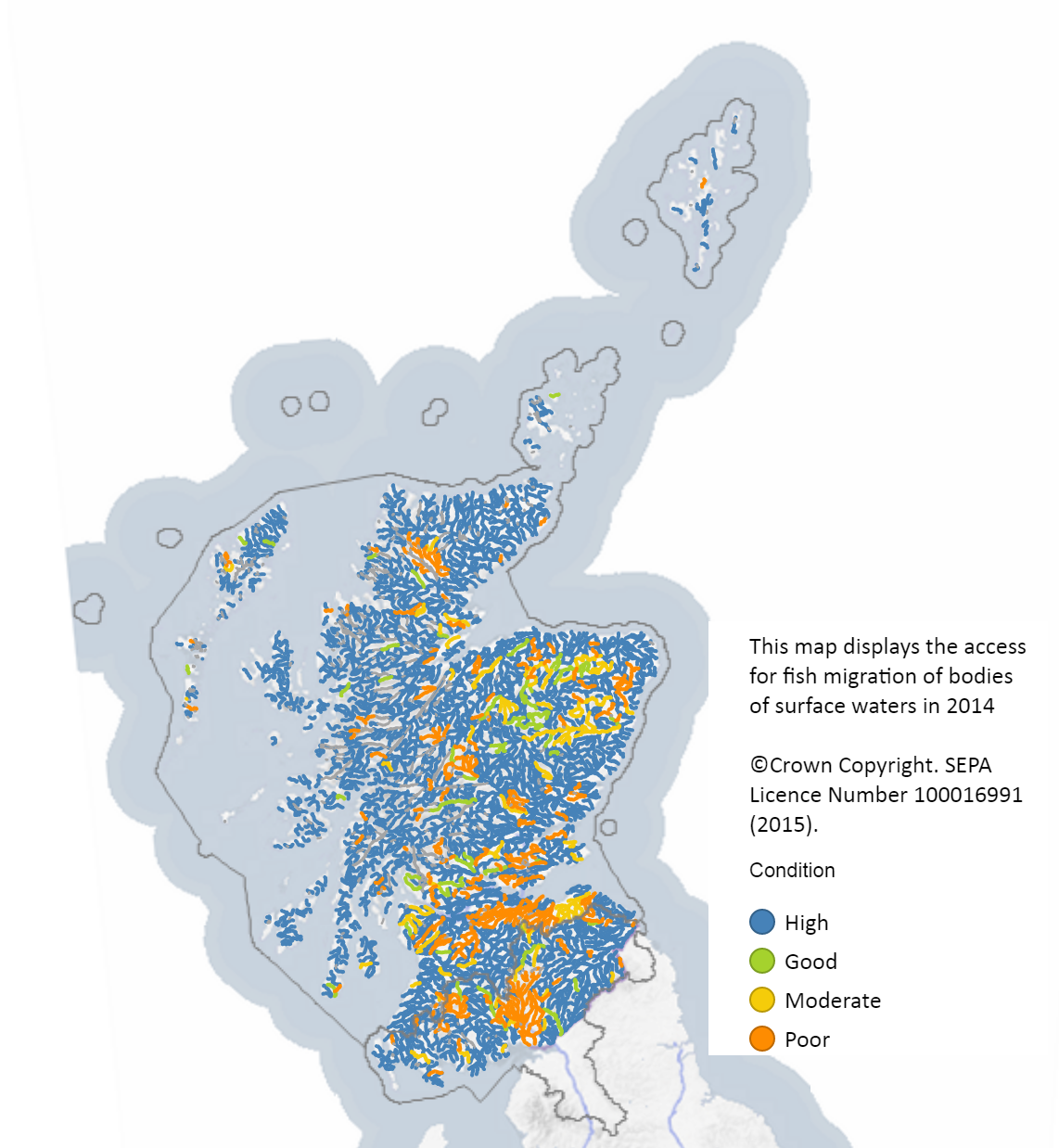
Barriers have also been shown to cause problems for the passage of smolts as they migrate downstream, in some cases leading to delays and increased mortality. Smolts may be delayed due to the impoundments above barriers having a reduced velocity which slows fish migration and alters flow paths, concealing the appropriate route past the barrier. The downstream migration of smolts is driven by various environmental cues, in order for the smolts arrival in the marine realm to match the timing of appropriate conditions for survival. Delays due to barriers may result in a mismatch in this timing, meaning that, on arrival at the coast, conditions may be less appropriate for smolts and therefore reduce their survival changes. The extra energy required to pass barriers on migration may also mean that they arrive with low energy reserves8.
In addition to waterfalls and man-made dams and weirs, beavers also create dams which may affect water flow and provide an obstacle to fish migration9. In Scotland, beavers have recently been reintroduced and are now a protected species1011. The distribution of potential beaver woodland habitat to which they could spread indicates there is a large overlap with salmon rivers. This suggests the potential for beaver-salmon interactions in these locations in future. Spring salmon, which tend to use upper tributaries of rivers, are likely to be most vulnerable to additional obstacles from beavers12.
Implications for management
Removal of barriers in rivers can enable improved passage of migrating salmon through rivers. Various obstructions have successfully been removed from several rivers in Scotland, restoring access for fish1.
Where physical removal is not possible, various types of fish passes - or fish ladders - can be used to enable fish to pass difficult or impassable barriers during their migration2. The location, design and water flow of the fish pass entrance as well as the water flow and design within the fish pass will determine how well fish can overcome the barrier. Water flow and depth are important in determining the salmon's maximum leaping capacity, meaning an obstacle in a low-flow section of a river may be harder to pass. Location of the entrance to the fish pass is important as fish may become delayed if they cannot find the entrance. Excessive turbulence at the base of the barrier may disorient fish or prevent passage at high water flows3.
Fish passes could be installed over impassable natural waterfalls to create new spawning habitats for salmon. This could help compensate for loss of habitat elsewhere. This occurred after hydroelectric power development on the River Conon, making the River Bran accessible beyond the previously impassable Conon Falls4.
For smolts migrating downstream, 'trap and tuck' operations can be employed in which smolts are caught in traps and transported below any barriers to help them reach the sea. This has been employed on Loch Shin to help smolts pass the Lairg Dam5.
River flow rate
Salmon have specific flow rate requirements, which will vary depending on their life stage and may at times affect different salmon in opposing ways. For example, a high flow in spawning grounds may negatively affect young fish or eggs, but a similar flow may be required for adult upstream migration1. The effects of flow on fish may be direct (e.g. being transported by currents) or may be indirect, related to its effect on dissolved oxygen concentrations, temperature, water quality, sediment transport and food delivery1. Some of the ways flow rate affects salmon at particular life stages are as follows:
Eggs in gravel redds
Require a high enough flow to maintain oxygen levels to the eggs and prevent deposition of fine sediments1.
Extreme high flows can damage spawning habitat and eggs4.
Low flow conditions can result in a greater input of groundwater which contains a lower oxygen concentration5.
Young fish
Adopt a 'sit and wait' feeding strategy, maintaining their position in low flow currents adjacent to a high flow that supplies food6.
Large floods may transport fish downstream or even outside of river channel.
High enough flow needed to re-distribute young fish. Sustained low flow may lead to high fish density and greater competition, predation, spread of diseases and territorial aggression.
Low flow reduces available habitat and food sources1.
Migrating adults
Flow requirements for returning adults migrating upstream will vary depending on river size and configuration, the fish condition, the stage of migration and other environmental variables.
Flow too high or too low can prevent migration.
Passage of barriers is prevented at low flow.
Extended low flow periods can stop upstream migration and even lead to fish reversal or departure from the river8.
Other impacts which can negatively effect salmon at all life stages include increased river bank erosion at high flows leading to greater input of suspended solids. Low flow conditions can also increase river temperature, reduce dissolved oxygen levels, prevent dilution of pollutants and enhance deposition of sediments1.
Controls on flow rate
All rivers exhibit natural variations in flow rate to which river species have adapted. Natural flow patterns are predominantly determined by rainfall patterns, topography and the underlying geology. However, human activity may alter flow pattern beyond this natural range which may leave salmon less able to cope1. These anthropogenic drivers affecting flow rate include:
water abstraction (removal)
river regulation (impoundments and power station outlets)
flood risk management
land use changes (such as forestry and agriculture)
climate change.
Abstraction of groundwater can reduce seasonal and annual flows since groundwater input is an important component of river flow. Groundwater is relatively cool, meaning that a reduction in this source can increase river temperature which can impact salmon survival. Surface water abstraction can cause daily to annual fluctuations in river flow, especially during large public water supply operations. This can disrupt flow during salmon migration1.
Weirs and dams create impoundments which can reduce annual and seasonal flow further downstream. Flow regulation for hydroelectric power can result in rapid increases in flow from dam releases, which can be frequent, non-seasonal and vary in duration. The released water may have a different temperature to that of the river, and may also be depleted in oxygen. In response, salmon may either stay in place or move substantial distances away from the release. Sudden reductions in flow may also leave fish stranded in pools or outside the river1. The higher water flow may also attract migrating salmon, which can create difficulties for them finding the lower flow emanating from fish passes. This may lead to delays in their journey as they struggle to pass the barrier4.
Many river engineering works are focused on flood risk mitigation, involving channel straightening to enhance river conveyance; gravel removal to increase channel capacity; and removal of natural obstructions such as boulders and vegetation. These processes make water flow more efficient allowing water to be rapidly cleared from the floodplain. As result, high flows may become more intense. The effects of these flows on fish are exacerbated by the removal of different structures and 'refuge' habitats which salmon may use to cope with high flows. A reduced connectivity to the floodplain may make it harder for fish to access low flow conditions which are required at certain life stages1.
Riparian land use affects river flow, predominantly through the modification of run off from the land1. The amount of run-off will depend on the soil type, gradient and nature of drainage7. For example, sandy soils allow greater infiltration of rainfall into the ground compared to clay soils, but 'sealed' surfaces as a result of urbanization or soil compaction allow little infiltration, meaning much more water runs off the land into rivers, and much more quickly8. Vegetation on banks is important for reducing run-off from the surrounding land, meaning that removal of riparian plants could increase river flow. Agricultural drainage and high livestock numbers increase run off and the resulting river flows7. Livestock numbers, grazing management, field machinery use, timing of operations and the presence of retention ponds will all affect run off from agricultural land 8.
Climate change has already resulted in significant changes in rainfall patterns and river flow in Scotland, with further changes predicted over the coming decades. For Scotland as a whole, a 2002 study indicated a significant long-term increase in precipitation, particularly during the winter. However, these changes are not uniform across the country, but are most pronounced in the north and west, whereas precipitation in the south and east appears to have slightly declined. In contrast, the summer months have generally become drier, especially in the east. As a result of these changes, mean flow for most rivers has increased particularly in the south and west, most notably between the 1970s and mid-80s. Since then, most flows have stabilised except in the north and east where they have declined. Summer flows as a whole have also slightly declined11. Similar trends were observed in the subsequent years since this study. The summer of 2018 was one of the hottest and driest on record across the UK, leading to steep declines in many river flows12. The northeast and north of Scotland in particular experienced significant water scarcity and prolonged periods of low flows. The month of July saw 11 rivers' flow categorized as 'exceptionally low', with the majority of other rivers being 'low' or 'very low'13.
Predictions of future climate change suggest Scotland will experience wetter winters, drier summers and increased temperatures, but with regional variations, with an overall increase in summer drought. This is expected to result in increased periods of water shortages, with what is currently a 1 in 40-year drought, becoming a 1 in 20-year drought by the 2050s14. In response to increased winter precipitation, annual run-off for Scotland as a whole is predicted to increase by 5-15% by the 2050s, but in places reaching >25% locally11.
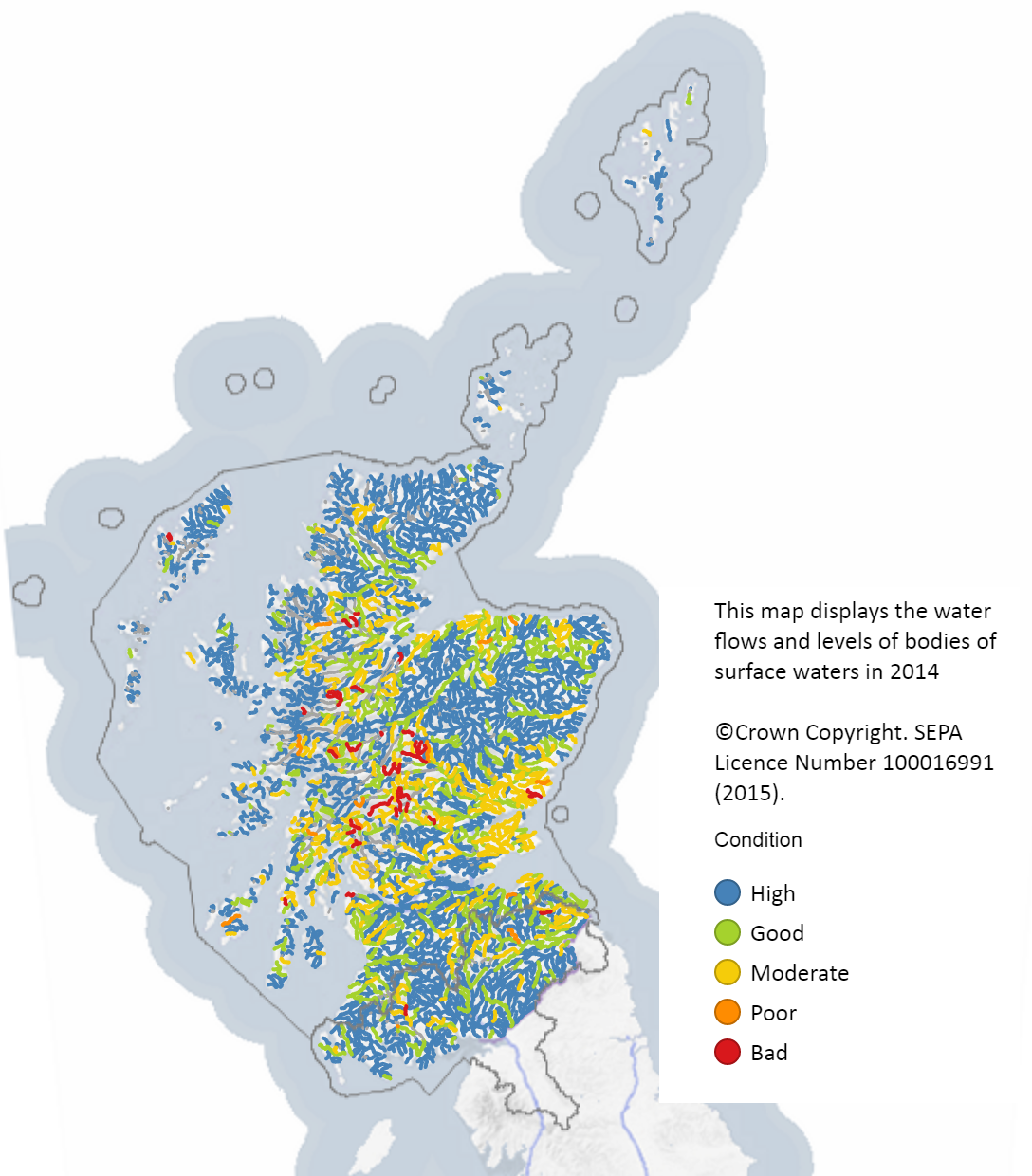
Implications for management
Various things can be done to improve river flow for salmon.
Restoration of rivers which have been straightened can reduce the intensity of high flows, such as through the replacement of natural obstacles like boulders and vegetation. These also provide deeper pools which salmon can use a refuges during low flow conditions. River restoration can also bring additional benefits for river temperature12.
Run-off from surrounding land, particularly farm land, also increases river flow. Reducing livestock numbers and varying field machinery use (which causes soil compaction), improved grazing management, consideration of the timing of operations and the creation of retention ponds can help reduce run-off and excessive high flows3. Planting of riparian vegetation can also reduce run-off, as well as having additional benefits for water quality, water temperature and food supply4.
In most of the UK, there is a single prescribed flow, or 'hands-off flow', below which water abstraction must stop4. However, this is not currently implemented under the general binding rules in Scotland, where abstraction is limited to 10m3 of water in any one day6.
Where flows are regulated for hydroelectric power generation, variable water flow throughout the season has been suggested to be better than a static water discharge. This increases the likelihood of the flow meeting the requirements of individual salmon in different phases of their upstream migration. However, the variation should not be too fast or large that stress levels and fish strandings increase7. In Scotland, 'freshets' - the water released from hydro schemes - have set dates and times of release. On the River Awe, a 'smolt freshet' is released if there is known to be a build up of smolts upstream due to low flow8.
Food supply
Young fish will feed on invertebrates, particularly aquatic insect larvae including mayfly, stonefly and caddisfly. Occasionally terrestrial insects will also be taken from the surface of the water. In contrast, returning adults will not feed during their river migration and spawning process1. The abundance and supply of these food sources to young salmon can affect their abundance and distribution2.
Aquatic invertebrate abundance can be affected by:
nutrient input
water quality
water temperature
flow rate.
The invertebrate community will be determined by the primary nutrient source. In tree-lined rivers, this will be provided by leaf litter falling into the water which are a food source for many insects. Where trees are mostly absent, allowing high light levels, algae can form in the water which instead becomes the base of the food chain3.
Terrestrial insects were found to make up 24% of the diet of wild salmon parr in one study in a Russian river4. Riparian vegetation provides plant detritus to rivers which is the principal food source for many aquatic and terrestrial invertebrates in rivers. The presence of riparian vegetation also directly influences the abundance, composition and rate of supply of terrestrial invertebrates to rivers, with insects falling of plant foliage into rivers5.
However, too much stream side vegetation could also have negative effects on food abundance due to the effects of shading. A reduction in light levels can lead to a decline in primary production in rivers (e.g. algae), with knock on effects higher up the food chain, reducing the abundance of invertebrate prey for salmon6.
Many of Scotland's rivers are oligotrophic (having low nutrient concentrations). Increasing nutrients in streams through transport of salmon carcasses in one study was found to increase abundance of invertebrates five times more than streams without carcasses. This led to faster growth of juvenile salmon over the next two years7.
The effect of water quality on food supply has been previously mentioned, as both suspended solids and pesticide input can reduce invertebrate abundances.
Water temperature can have direct effects on invertebrate populations in rivers. Evidence suggests that increasing temperatures as a result of climate change can result in the local extinction of 'cool-water specialist' species. Indications suggest that the loss of species due to extinction outweigh gains made by other species changing their range in response to climate change. Experimental evidence also suggests that warming can decrease invertebrate densities, advance the timing of insect emergence, changes growth rates and size and alter sex ratios, although there is no direct evidence of these from the UK8.
Evidence from English rivers have shown that flow rate can affect invertebrate abundances. Droughts were found to cause a reduction in abundance followed by a recovery, while high flows also effected invertebrates, but to a lesser extent. However, there is uncertainty about the effect of prolonged low flows, such as over a number of years8. Flow rate is important for young salmon who adopt a 'sit and wait' feeding strategy, maintaining their position in low flow currents adjacent to a high flow that supplies food10.
Implications for management
Restoring rivers to a more natural state can increase abundances of invertebrate food sources in various ways:
Creation of deeper pools which provide a refuge for aquatic invertebrates during low flow conditions.
Creation of riffles (shallower areas) and gravel bars which are important habitats for many invertebrates.
Woody debris in rivers provides a surface for insects to colonise1.
Riparian vegetation increases input of leaf-litter and woody material, providing nutrients to support the food chain1 and direct input of terrestrial insects3. This also has additional benefits for water temperature, water quality and river flow. However, too much shading from riparian vegetation can reduce primary productivity (e.g. algae) which may reduce invertebrate abundance4.
Illegal poaching
Fish poaching was the most common wildlife crime in Scotland as recorded by the police between 2012 and 2017, the majority of which were in relation to salmon between April and September. These ranged from 68 recorded fish poaching crimes in 2016-17, up to 135 in 2012-13. In 2016-17, these were most commonly recorded in the Highland and Islands division, followed by the North East. Despite being the most common, fish poaching crimes have the lowest average monetary fine compared to other wildlife crimes1.
Implications for management
The Salmon Carcass Tagging (Scotland) Regulations 2016 came into force March 2016. This states that any salmon caught by net in inland water must have a tag attached to the carcass containing a unique reference number and the name of the salmon fishery where it was taken1. Since it is illegal to sell a rod caught salmon under the Conservation of Salmon (Prohibition of Sale) (Scotland) Regulations 20022, this means that fish with a legitimate carcass tag are the only ones which can legally enter the market3.
Fish poaching crimes currently have the lowest average monetary fine compared to other wildlife crimes. The Wildlife Crime Penalties Review Group 2015 report made several recommendations including increasing potential penalties and the use of conservation/ecological impact statements. Implementation of these recommendation may act as a greater deterrent against to illegal poaching than currently4.
Invasive non-native species
The introduction of non-native species can have detrimental effects on native species. This may be through competition, predation, consumption of plant materials, habitat alteration, spread of disease and genetic effects (e.g. hybridization)1.
Pink salmon is a species of salmon native to the Pacific which has occasionally been caught in Scotland. These fish were introduced into certain Russian rivers which drain into the North Atlantic and have since spread south. Just one or two fish were caught in occasional years over the past few decades, with a maximum of five caught in 1973. This was until a record of 139 pink salmon were observed in Scottish waters in 2017 with some even observed spawning in a handful of rivers in August and early September. Due to the difference in spawning timing with Atlantic salmon, it is unlikely that there will be any competition between the two species for spawning habitat. Also, scientists are predicting that offspring of the pink salmon that spawned would probably suffer very high marine mortality. This means they are unlikely to be a threat to the Atlantic salmon2.
The North American signal crayfish is another invasive species which has been found in several streams in Scotland. This was introduced from North America in the 1940s. There is currently little information about the interactions between the signal crayfish and Atlantic salmon, but initial research has suggested that the crayfish may outcompete young salmon for shelter in winter. This may increase the vulnerability of the young salmon to predators3.
The American mink is a non-native species which became established in Britain in the 1930s. Mink are known to predate on various fish, including salmon, and so may cause mortality of young or returning salmon in rivers4 as mentioned above. However, currently no studies have assessed the impact of mink on salmon populations in Scotland.
Various other invasive non-native fish species have been found in Scotland's waterbodies including the ruffe, carp, bream and gudgeon which were introduced into Loch Lomond5. The ruffe can eat the eggs of salmonid species which may cause problems on salmon rivers6 but there appears to be little research on the effect of these species on salmon.
Invasive plants can also affect fish populations where river banks are dominated by them. Himalayan balsam often forms dense stands on river banks which can increase soil erosion (after die back in winter) affecting water quality and flow rate, and lead to a reduction in invertebrate diversity reducing food supply for salmon7.
Pressures on salmon in estuaries and the coast
Once salmon have transformed into smolts, they will migrate downstream, passing through estuaries and the coastal zone into the marine environment. This transition from freshwater to coastal waters is considered to be a period of high natural salmon mortality, which can exceed 60% in the first 40km of coastal waters1. Here they will experience a different set of pressures on their survival, including:
salmon farming
predation by seals, birds and fish
overexploitation.
Finfish aquaculture
Salmon and sea trout farming, or aquaculture, in Scotland developed in the 1970s, since which Scotland has become the largest producer of farmed Atlantic salmon in the EU, producing more than 162,000 tonnes in 2016. Salmon farming takes place entirely on Scotland's west coast and islands, with no farms in the east1. Since salmon spend part of their lives in freshwater, farmed salmon are hatched and reared in land-based hatcheries, then in some cases transferred to cages in freshwater lochs once they reach a certain size 2. Once they become smolts, they are taken to marine farms, mostly located in sea lochs and inlets3.
Many farmed salmon escape from aquaculture into the wild every year, with more than 47,000 escapees being reported in Scotland in 20184. It is possible that many are unreported, as is the case in Norway where escapees have been estimated at 2-5 times higher than official statistics, but there is no estimate of under-reporting for Scotland5.
Escapees may occur from both marine and freshwater stages of production, and some are known to enter rivers where it is possible for them to spawn with wild salmon. Farmed salmon have been observed spawning with wild fish in Scotland. Currently the level to which this occurs is unknown5. However, work is being undertaken using genetic sampling of wild salmon to determine the level of introgression (the transfer of genetic information) in Scottish salmon7. Research in Norway found that 21 out of 34 wild salmon populations investigated indicated moderate-to high risk for genetic introgression from farmed escaped salmon8.
The impact that interbreeding will have on wild salmon depends on the life stage of escapees and the time of year. This may result in genetic change in wild populations which have been shown to:
reduce the viability of populations in rivers
decrease overall productivity of the wild population
decrease in genetic diversity and resilience over long-time scales5.
Farmed salmon are at risk of sea lice - parasites which live on the skin of fish. Sea lice can damage the fish directly, as well as making them more susceptible to infections and disease 1. Salmon farming increases the abundance of lice in the marine environment and can cause significant mortalities of farmed fish, and increase the risk of infection and mortality in wild populations in areas with fish farms5. Research has shown that wild Atlantic salmon in farmed areas generally have higher numbers of sea lice, which also have the same resistance to chemicals used in fish farms12. Smolts will be more vulnerable to sea lice due to their smaller size. More than 0.3 lice per g of fish weight is thought to cause 100% marine mortality, with 0.2 - 0.3 lice per g of fish weigh causing 50% mortality8.
However, there has also been an observation of adult fish in the lower section of the Blackwater River, distressed, dead or dying as a result of many sea lice. These fish would have passed several salmon farms in Loch Roag14.
The Scottish Government has produced a summary of the science relating to the impacts of salmon lice from fish farms on wild sea trout and salmon15; this notes that no “empirical information exists on impacts of lice on wild populations of salmon in Scotland”, and whilst declines in “catches of wild salmon have been steeper on the Scottish west coast [where fish farms are located] than elsewhere in Scotland and Norway”, a “causative link with aquaculture” has not been proven. Furthermore:
Salmon aquaculture can result in elevated numbers of sea lice in open water and hence is likely to increase the infestation potential on wild salmonids. This in turn could have an adverse effect on populations of wild salmonids in some circumstances. The magnitude of any such impact in relation to overall mortality levels is not known for Scotland. Concerns that there may be a significant impact of aquaculture were raised initially due to declines in catches of both salmon and sea trout on the Scottish west coast. There is scientific evidence that individual Scottish sea trout can experience physiologically detrimental burdens of salmon lice in areas with salmon aquaculture but the effects on populations in different areas is not known. International scientific evidence from Norway and Ireland indicates that early protection against salmon lice parasitism results in reduced absolute marine mortality, and reduces the time spent at sea, indicating that salmon lice can influence the population status of wild salmon.
There is also a lack of information on the potential for transfer of disease between farmed and wild fish, and the Government’s Ministerial Group for Sustainable Aquaculture has identified the need for further research in relation to this16.
Implications for management
The Scottish Government has established a Salmon Interactions Working Group to look into the decline of Scottish Atlantic salmon, in particular looking at interactions between wild and farmed salmon. This group aims to make recommendations for a future approach to managing farmed and wild fish interactions, aided by a technical working group, which is developing practical arrangements for improving regulation in the area12.
The technical standard for Scottish finfish aquaculture aims to prevent fish escapees, implemented under the Aquaculture & Fisheries (Scotland) Act 2013, involving specific instruction for manufacturers3.
Predators in estuaries and the coast
Once salmon reach estuaries and the coast they may be faced with a new set of predators. These include:
seals (grey and common)
other fish (e.g. cod, saithe, sea trout)
birds (e.g. gulls and cormorants).
The transition from rivers to seawater can cause 'osmotic stress' in fish, due to the increased salinity, which affects salmon behaviour and may reduce their ability to escape predators1.
Seals
Both grey and harbour seals are commonly found around Scotland's coast and in estuaries where they may predate on salmon1. The impact of seals on salmon in rivers has been discussed above.
One study using DNA analysis found that faeces collected from seals in rivers more commonly tested positive for salmon, compared with those from coastal sites. This suggests that removal of seals from estauries will have less of a benefit to salmon per seal removed, compared to seal removal in rivers2.
Other fish
Outgoing smolts reaching the marine phase of their migration may be predated on by other fish including returning adult salmon, cod, saithe, sea trout and eels1. The Atlantic cod is an opportunistic feeder which may feed on post-smolts as they enter the coastal zone2. A study from an estuary in Norway estimated predation of 20% from cod alone in a particular area3. However, there is currently little research on the effect of fish predation on Scottish salmon.
Birds
Various birds species may predate on smolts as they enter estuaries and the sea, such as gulls, cormorants and gannets.
One study in Denmark tagged a number of smolts as they travelled down the lower stretch of a river, through an estuary and into the sea, which involved passing colonies of cormorants and herring gulls. They found that predation in the river was relatively low (3 out of 27 smolts) but rapidly increased after smolts passed into saline water, with 6 smolts predated within 9 hours of entering the estuary, and another 4 within the first 2 weeks. Smaller smolts were predated on more often than larger ones. Although osmotic stress due to the changing salinity may have played a role in the increased predation at this time, salinity in the estuary was measured to be fairly low meaning salmon would have been able to find ambient salinity. However, this means smolts were more likely to use the surface waters where they would be more visible and easier to catch by predators1. Salmon smolts are known to predominantly swim at shallow depths as they migrate from rivers to the coast2.
In the northwest Atlantic, gannets were found to have increased their consumption of smolts in the 1990s in response to a shift in the ocean food web, with potential to negatively affect North American Atlantic salmon populations3. Although no equivalent studies have been done for Scottish populations of salmon, Scotland holds 40% of the worlds population of breeding gannets4 meaning there is potential for gannets to predate on Scottish salmon.
Implications for management
Implications for managing seal and bird predation in rivers has been mentioned above. Tracked smolts migrating through the River Deveron were found to migrate into the marine environment predominantly at night, and at higher swim speeds than in the river. This is suggested to be a predator avoidance strategy, and may suggest salmon smolts are better able to avoid predators in this environment compared to in rivers1. DNA analysis suggests salmon is less commonly a part of a seals diet in the coast than in rivers, indicating that seal removal in estuaries will be less beneficial to salmon than removal of seals in rivers2.
Overfishing
Overfishing, or overexploitation, occurs when fish are caught faster than stocks can be replenished, and can lead to a decline in fish abundance. The number of overfished stocks has increased globally over the last half century1.
The Conservation of Salmon (Scotland) Regulations 2016 states that killing of salmon in coastal waters is prohibited, and only permits the killing of salmon in rivers (including estuaries) where salmon numbers are above a defined conservation limit2. Net catch in Scotland has been in decline since a peak in the late 1960s, mostly due to the closure of many net fisheries3. This was driven by reduced marine survival since the 1980s resulting in fewer fish at the coast, and the significant increase in cheap farmed fish4.
Despite closure of the majority of netting stations around Scotland's coast, and the associated reduction in netting effort, salmon numbers have continued to decline since the 1980s. There was, however, a slight overall increase in rod catch in rivers until 2010, which may have been the result of the decline in netting (FMS, pers comms), but despite this, salmon numbers have declined significantly since then3.
Implications for management
Current legislation preventing the killing of salmon in coastal waters, the significant decline in commercial net fisheries, along with the widespread uptake of catch and release of salmon in rivers, means there is little scope for reducing exploitation much further1.
Pressures on salmon in the open ocean
Once salmon reach the ocean, they can undertake significant migrations which may take them thousands of miles across the ocean, into the waters of other countries including Norway, Iceland, Greenland and potentially even North America. However, the full details of their migration pathways is not entirely known1, which makes it difficult to fully understand the pressures they may face during this life stage.
Salmon have high ocean mortality rates of 65-95%2. Estimates of post-smolt survival at sea using a life cycle model have indicated a decline in marine survival for different populations across the North Atlantic3. The widespread decline of salmon and the coherence in trends in abundances over time across North Atlantic regions suggests that factors covering large geographical areas, particularly changing climate and ocean conditions are behind their decline4. In contrast to juvenile salmon in rivers, survival of adult salmon at sea is density-independent, meaning that survival is not dependant on how many there are5. Returns of adults are poorly-predicted from estimates of numbers of smolts going to sea, suggesting that survival from year to year is not dictated by smolt production2.
Some pressures which have been identified as having an impact on salmon survival include:
Climate change
Food supply
Predation
Overfishing
Marine energy
Climate change
Climate conditions, particularly sea surface temperatures, have been closely correlated with growth and survival in 'post-smolts' - adult fish in the early stages of their marine migration. One study of salmon from the Girnock Burn, Aberdeenshire, found that growth rates in the early marine stage were significantly negatively correlated with sea surface temperatures in both April and June, between 1982 and 1994, indicating lower growth of salmon at high temperatures. They also found close coherence in post-smolt early marine growth for fish from the Girnock Burn and the North Esk, suggesting a common driver of the two. However, it is unclear whether the warm conditions are the direct mechanism inhibiting growth or not, or whether it could be indirectly linked through other effects of climate change1. Other studies have shown evidence that winter temperatures are also correlated with changes migrating salmon growth and survival, but, in contrast, high sea surface temperatures being positively correlated with salmon survival2.
Abundances of salmon have been found to correlate with major climate oscillations in the North Atlantic, including the North Atlantic Oscillation and the Atlantic Multidecadal Oscillation. The North Atlantic Oscillation (NAO), one the main climate phenomena affecting weather in the Northern Hemisphere, is driven by pressure differences between the Azores and Iceland. Its positive phase results in warmer and stormier weather during winter, compared to colder and calmer winter conditions in its negative phase3. One study of recaptured salmon from Norway found that the positive NAO phase was associated with a higher mass increase and more fish maturing after one sea winter (grilse), due to the more favourable winter feeding conditions, suggesting that the weather during the positive phase was beneficial for this particular group of salmon2.
The Atlantic Multidecadal Oscillation (AMO) is another climate mode affecting marine conditions, but on a longer term cycle of 50 - 90 years. A study of North American Atlantic salmon abundance since 1910 found these to be closely correlated with the AMO, with greater catches associated with the colder, negative phase. This suggests that the warmer temperatures create less favourable conditions for salmon survival, at least in the northwest Atlantic. However, the authors point out that the variation in sea surface temperatures are too small to have a direct effect on salmon survival themselves, meaning this correlation is more likely to be associated with changes in predators and prey5. Strong correlations were also found between the AMO and salmon catches in the northeast Atlantic, between 1960 and 2010, also suggesting that the colder, negative phase was more beneficial for these salmon6.
In addition to salmon survival and growth, changing climate and ocean temperatures may also effect the geographic distribution of Atlantic salmon, particularly affecting those at the southerly edge of their range. A northward shift in distribution has been observed in many other fish stocks in the northern hemisphere, associated with increasing sea surface temperatures7. This has also been observed for Atlantic salmon in North America, where the southern edge of their range is thought to have shrunk by 2 degrees latitude8. Climate change might also explain while salmon from rivers in the more southerly part of their range on both sides of the North Atlantic are declining the most rapidly6.
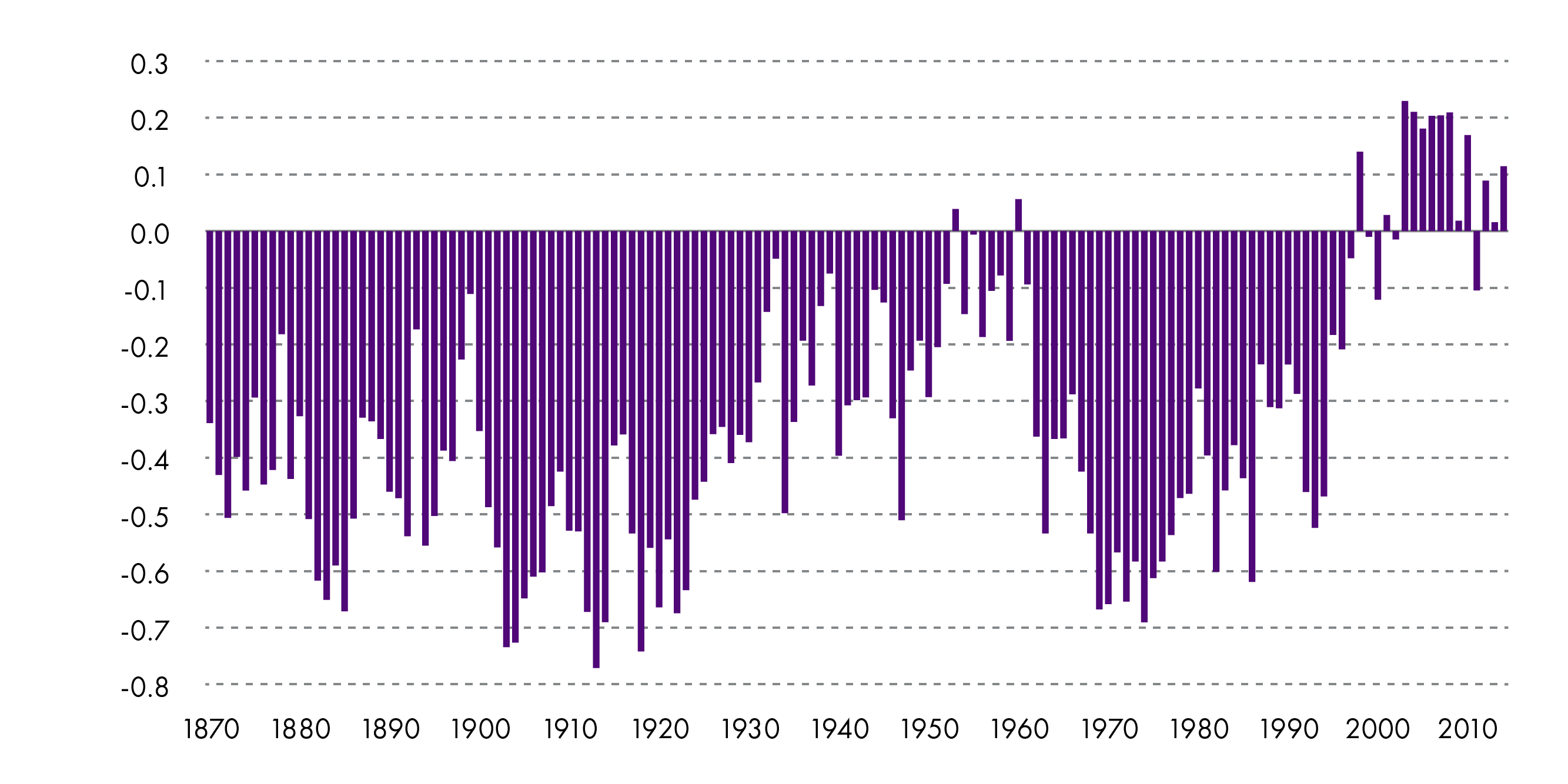
The North Atlantic has experienced significant warming since the 1970s as a result of anthropogenic climate change. The oceans are projected to warm globally as a result of climate change, however, some predictions suggest this warming will be weaker in the North Atlantic, or may even cool slightly as a result of changing ocean circulation11.
These research studies indicate that changing sea surface temperatures are associated with significant changes in salmon abundances. However, it is not clear whether the described effects on Atlantic salmon are a direct effect of warming, or may be indirect through changes in the location and abundance of prey or predator species5.
Food supply
Salmon migration to the ocean is driven by the increased provision of food resources in the marine realm1. As a result, salmon growth is significantly enhanced in the marine phase compared to in freshwater2. Here they eat a range of different prey, including fish, such as blue whiting, herring and sandeels, and various zooplankton3. Changes in the distribution of various zooplankton species have been observed in the North Atlantic in response to changing sea surface temperatures and ocean circulation. This includes a northward extension of warm water species, and a decrease in the number of cold-water species4. Such changes in prey species may have bottom-up effects on predators higher up the food chain, including salmon5.
One study of salmon stocks from the northeast Atlantic found that the long term decrease in salmon abundance was correlated, not only with an increase in sea surface temperatures, but also with declines in a range of zooplankton species, including euphasiids which may be a large part of the diet of post-smolts. The mechanism behind these correlations is likely to be changes in sea surface temperatures directing acting on the survival and distribution of these plankton, resulting in a reduction in the size and abundance of salmon, food source6.
Predation
Once salmon reach the open ocean they become prey for a new range of predator species. Atlantic salmon post-smolts have been found in the stomach of a variety of fish including cod, skate, halibut, pollock and Greenland shark. They are also eaten by various seabirds and marine mammals. However, understanding the effect of predation in the marine realm is difficult due to the rarity of salmon in the open ocean, making up only a very small fraction of total biomass and predator diet1.
A recent study involving tagged salmon from 12 rivers on both sides of the North Atlantic was able to pinpoint the location of 22 definite predation events during their ocean migration. Based on recorded light, temperature and depth data, 23% of the predators were identified as marine mammals such as toothed whales, 18% as cold-blooded fish, such as blue sharks or swordfish, and 59% as warm-blooded fish, such as bluefin tuna and porbeagle sharks (in the northwest Atlantic at least). They also identified 38 unknown mortality events, some of which occurred in coastal areas where large numbers of seals are present and meaning seal predation may have been the cause of mortality. The data showed a geographical trend, with the lowest predation and mortalities in the northeast North Atlantic (Norway and Denmark), the highest in Canada and Spain, with Ireland somewhere in the middle, although uncertainties in actual mortality and predation rates should be noted. This spatial pattern correlates with ongoing observed trends in population abundance suggesting that predation may be an additional stressor to vulnerable populations. However, it should be noted that this study only looked at adult salmon on their repeat ocean migration, so may not be applicable to smolts2.
A study from the Gulf of Maine in the northwest Atlantic found that changes in spring winds and sea surface temperatures as a result of climate change have increased the vulnerability of post-smolts to predation. This is due to changes in the wind-driven transport of post-smolts, increasing the length of time in habitats where they are vulnerable to predators, and warming conditions increasing the abundance of several potential predators, including fish, marine mammals and seabirds3. However, this may not be applicable to Scottish salmon who are unlikely to reach this area on migration.
More recently, mackerel have also been proposed as being important predators of young salmon. Some researchers have said that mackerel have increased in numbers significantly in the waters around Scotland and may be eating young salmon as they migrate towards Norway, Greenland and Canada4.
Overfishing and bycatch
Due to the nature of their migrations, salmon are subject to a range of different fisheries. These include those targeting individual river stocks as well as distant, mixed-stock fisheries in coastal waters of other countries and, previously, on the high-seas, both of which incorporate fish from a variety of regions1. This creates challenges in managing stocks with respect to safe biological limits as they have to take account of the differing conservation status of each stock1.
Total North Atlantic salmon catches reflect a combination of:
salmon abundances
changes in fishery types
management measures.
This means that the status of salmon stocks cannot be directly assessed purely from data on catches. Declared catches of Atlantic salmon peaked at around 12,000 tonnes per year in the 1960s and 70s, mainly in response to the development of driftnetting in coastal waters (particularly European) and the large driftnet fishery in West Greenland. The West Greenland fishery exploited one-sea-winter fish (grilse) which originated from both North America and southern Europe. The Faroese longline fishery also developed in the 1970s mostly taking fish from northern European countries1.
In response to the development of these fisheries in the 1970s and the decline in abundance of salmon in homewaters, the North Atlantic Salmon Conservation Organisation (NASCO) was set up in 1984 with the primary objective to contribute to the conservation, restoration, enhancement, and rational management of salmon stocks, based on the best scientific advice available. After adoption of the Convention for the Conservation of Salmon in the North Atlantic Ocean, fisheries developed conservation measures based on biological reference points - safe biological limits for exploitation of salmon stocks. These are used to determine a 'harvest strategy' which is a pre-agreed plan stating how salmon catches will be adjusted depending on stock size, condition of the fishery and biological uncertainties1. As well as this, fisheries targeting Atlantic salmon on the high-seas, beyond 12 nautical miles from the coast, were prohibited, including cessation of the large Northern Norwegian Sea fishery5
As a result of these measures, total salmon catches have now declined further. In particular, the West Greenland fishery, which peaked at > 1000 tonnes in the early 1980s, has declined significantly to around 20 tonnes in the early 2000s. However, many stocks are still of poor status, outside safe biological limits1.
Despite the closure of the high-seas salmon fisheries, Atlantic salmon are still at risk of being caught through bycatch - the unintentional catch of non-target species by other types of fisheries. In the 1990s, a large number of salmon post-smolts were taken in catches of mackerel in Norwegian research surveys in the Norwegian Sea during summer. This indicated the potential for large open-ocean fisheries, particularly for mackerel, take a large bycatch of migrating smolts as they move north during summer months. The ICES Study Group on the Bycatch of Salmon in Pelagic Trawl Fisheries has attempted to estimate the number of salmon caught as bycatch. Screening of catches from marine fisheries indicates small but consistent bycatches of salmon from various types of fisheries. In contrast, estimates based on extrapolation of commercial catch rates suggest several million smolts may be taken each year, but this is likely to be an overestimation. As a result, there are large uncertainties in the impact bycatch has on salmon populations7.
Marine energy
Offshore renewable energy developments have been identified by Marine Scotland as having the potential to impact various fish species including Atlantic salmon. There are some knowledge gaps, however potential impacts include:
displacement due to noise disturbance
impact on migratory patterns due to cable deployment
interactions with turbine blades e.g. collision
habitat loss
changes in fish behaviour e.g. clustering around devices
indirect effects e.g. influence on predator densities.
These identified knowledge gaps will be used to guide future Scottish Marine Energy Research projects12.
Implication for management in the open ocean
Management of salmon in the open ocean is challenging due to the substantial distance which salmon are known to migrate1 and the global nature of many of the pressures they face, such as climate change. Many of these relate to climate change which requires international cooperation to resolve2. The Scottish Government has introduced a new climate change bill which amends the Climate Change (Scotland) Act 2009 and proposes to set a 2045 target for net-zero emissions of all greenhouse gases3.
Mixed-stock fisheries have developed conservation measures to limit the overexploitation of salmon stocks, which has led to a significant decline in catches of salmon across the North Atlantic4.
Salmon which have been released with small PIT (Passive Integrated Tag) tags can be automatically detected during screening of commercial catches. This is currently taking place in 23 factories processing marine fish for human consumption in five European countries and can help better understand bycatch of salmon in fisheries5.